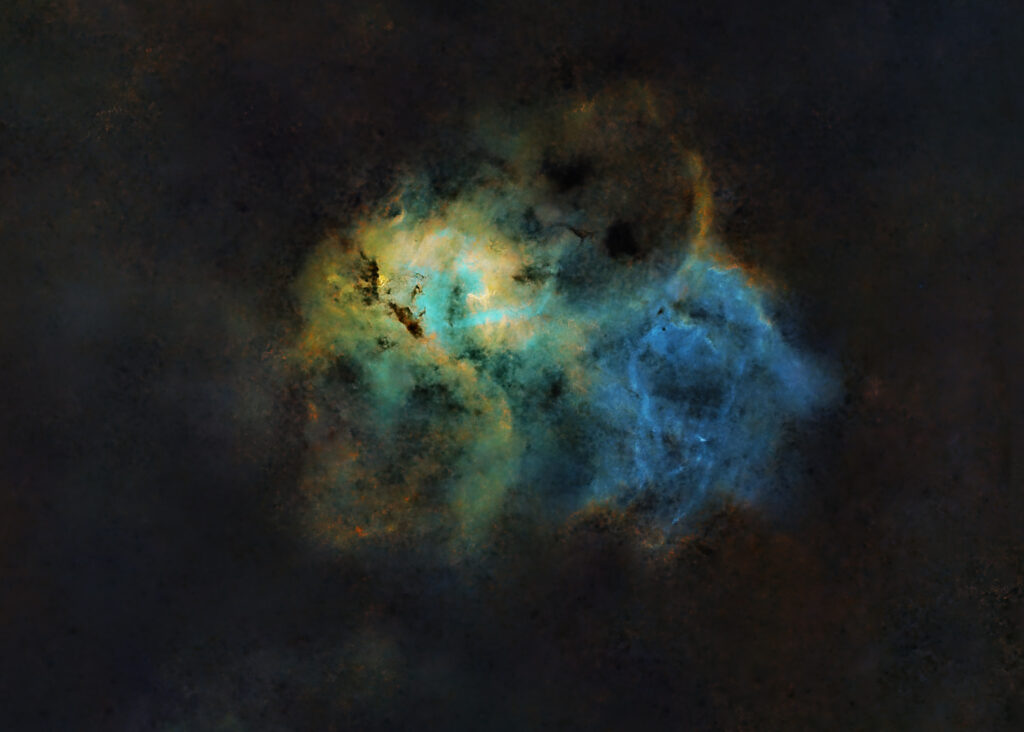C2023 E1 Atlas – LRGB – 17/07/2023
Comet C/2023 E1 Atlas from Ic Astronomy Observatory, Spain, Takahashi FSQ-106ED (106 mm) F3.6 telescope with CMOS camera QHY600M Pro.
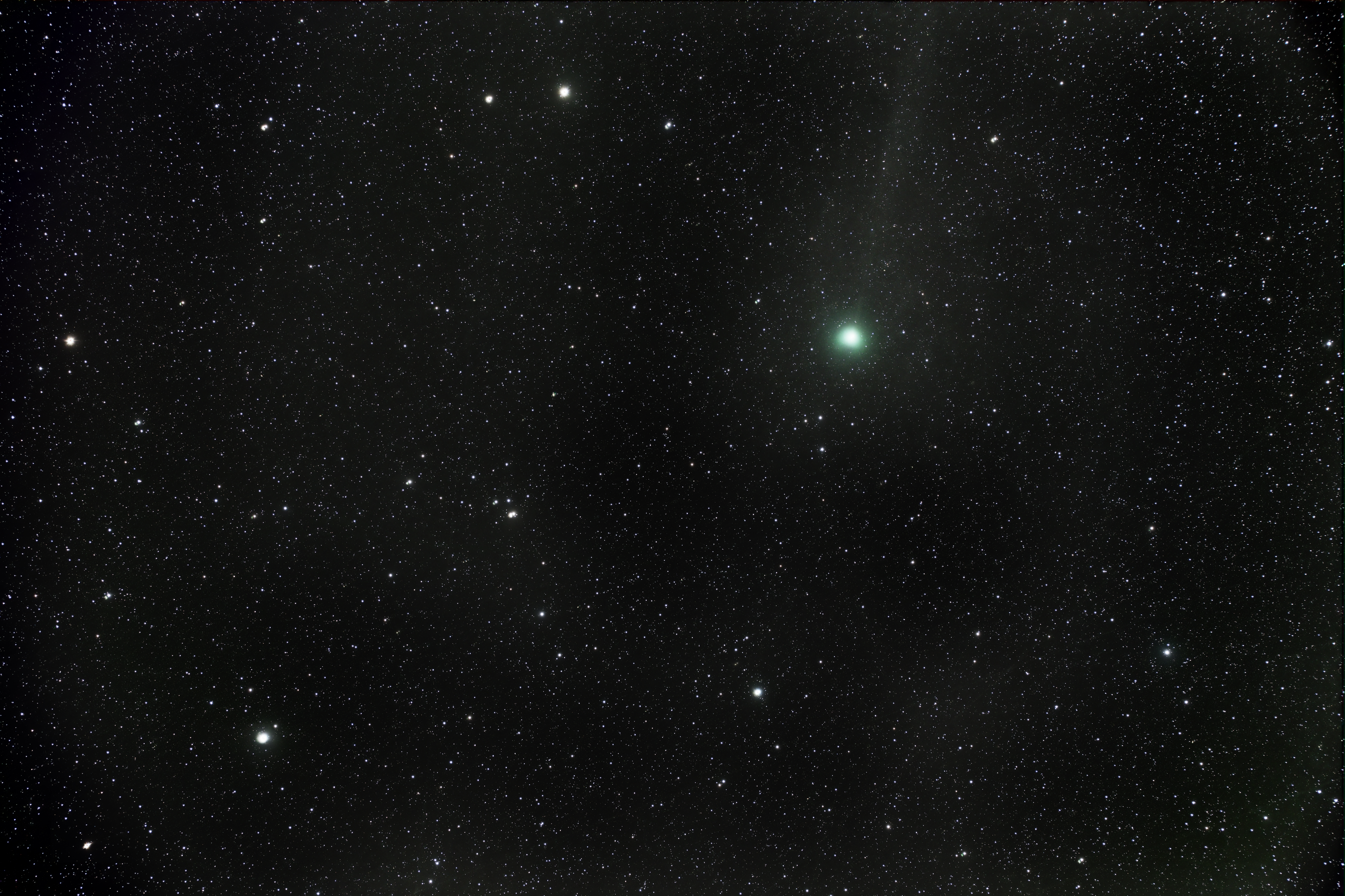
Astrobin: https://www.astrobin.com/ihrzvk/
Comet C/2023 E1 Atlas from Ic Astronomy Observatory, Spain, Takahashi FSQ-106ED (106 mm) F3.6 telescope with CMOS camera QHY600M Pro.

Astrobin: https://www.astrobin.com/ihrzvk/
Supernova SN 2023rve in NGC1097, LRGB channels.
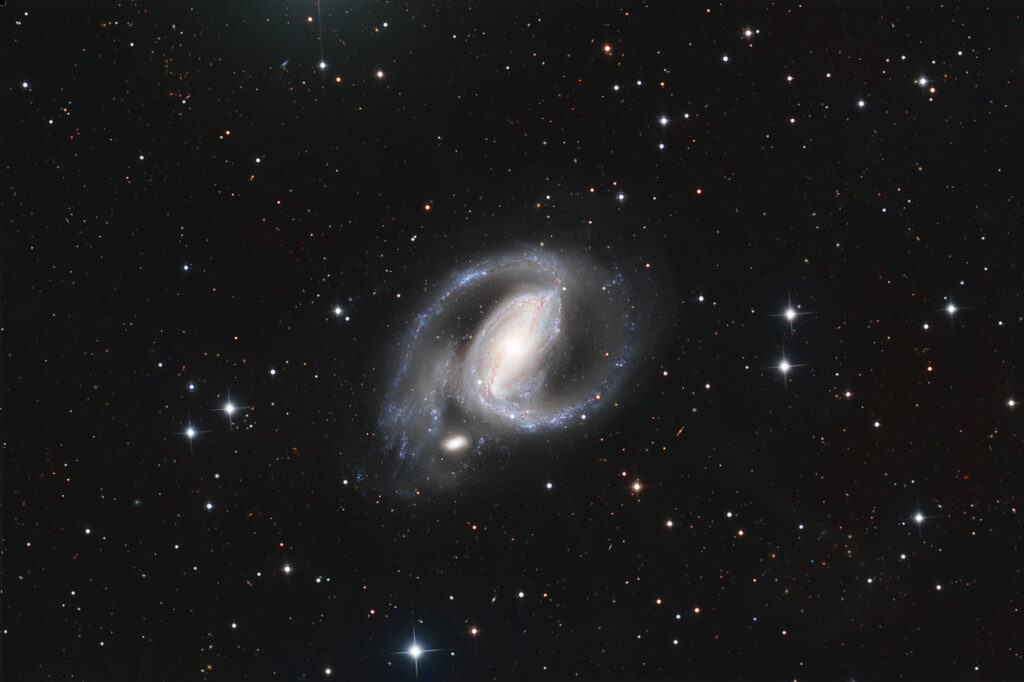
Astrobin: https://www.astrobin.com/66lpty/D/
Supernova recorded between 13 and 19 September 2023 by Planewave CDK24 and QHY 600M Pro CMOS camera from El Sauce Observatory, Rio Hurtado Vallei in Chile – Telescopelive network;
NGC1097 image without SN2023rve recorded by the same Planewave with CCD Proline FLI PL9000 between 23/02/2023 and 25/11/2022.
CCD subframes star-registred to CMOS (with SN2023rve) for right overlay on mouseover activity.
Photoshop layered masters available here:
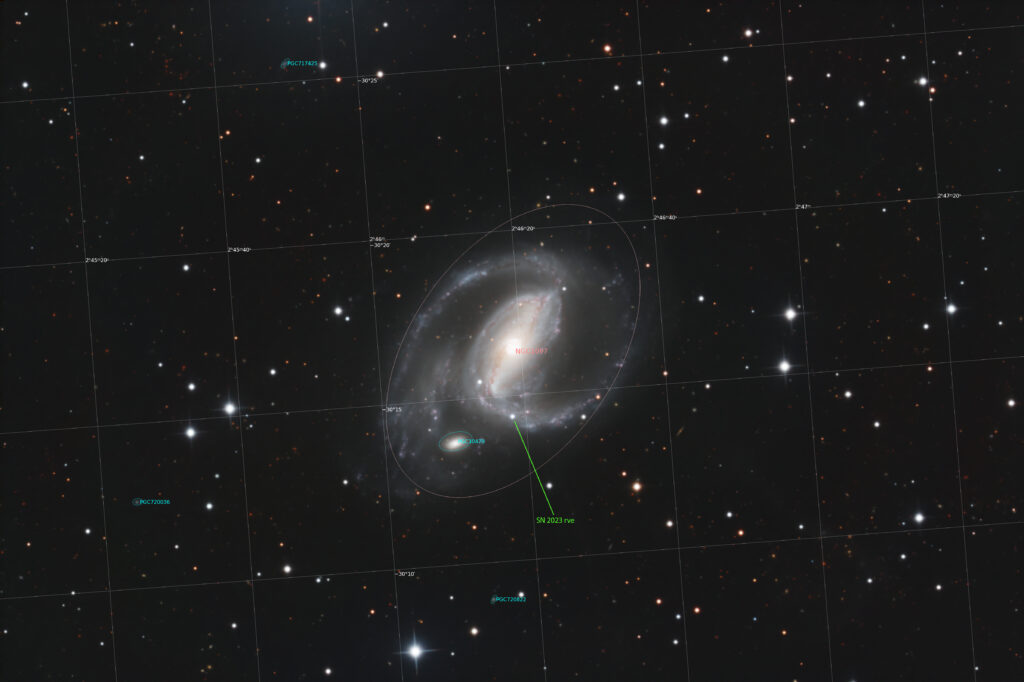
Preliminary and quick elaboration of Supernova SN2023rve in NGC1097 galaxy, data from Planewave CDK24 and QHY 600M Pro CMOS camera from Telescopelive.
Astrobin: https://www.astrobin.com/x9mdi4/F/
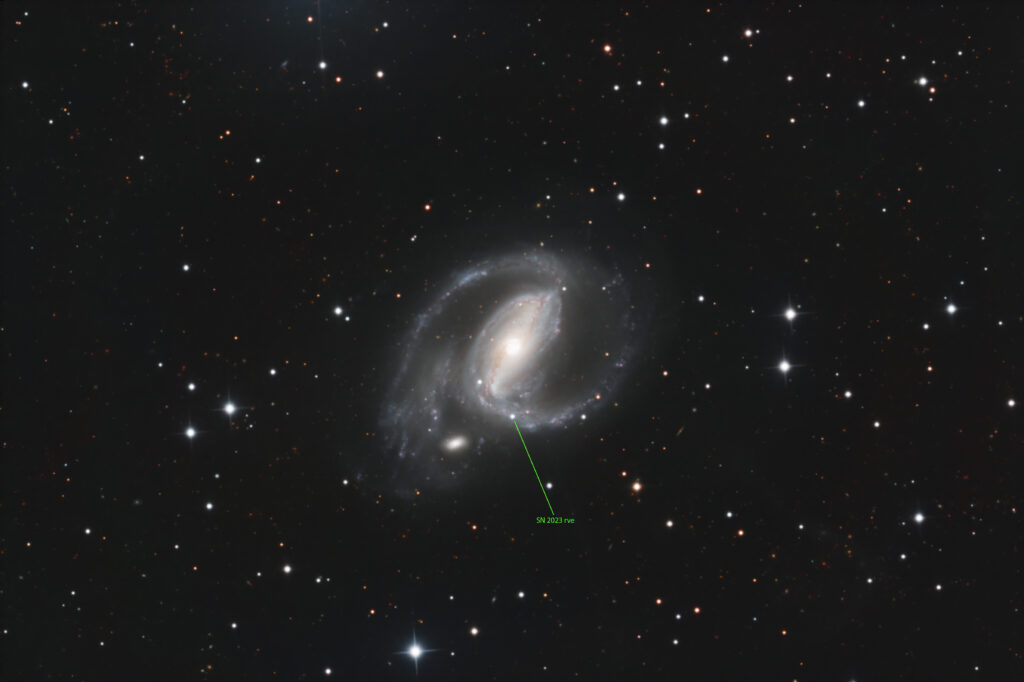
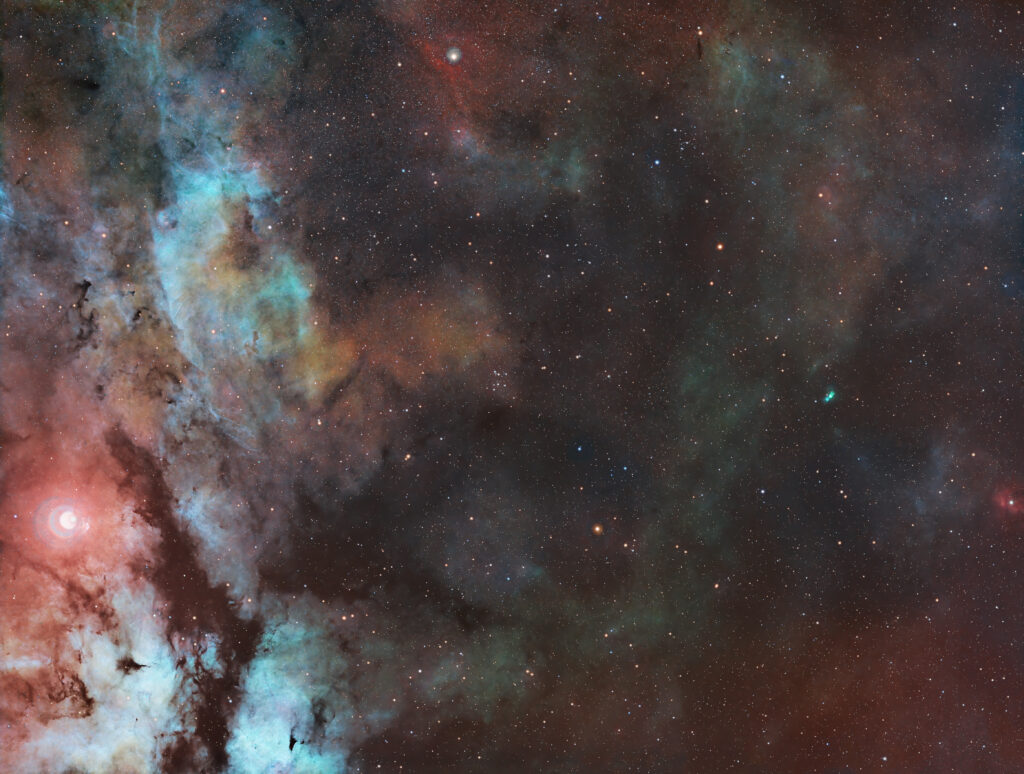
M29 region in narroband, Sii Ha and Oiii+Hb; Hydrogen Beta records I used to integrate Oxigen channel.
Setup is: William Optics Redcat 51 with ASI1600mm Pro, 180 sec. subframes recorded between 02/03/2023 and 31/07/2023; complete framelist available here > https://e.pcloud.link/publink/show?code=XZPA5WZ0i2eg9u3LjkdNdt14IDiRkQBfpVX
This is the second panel of a mosaic project I’m actually postprocessing.
Starless stage made during postprocessing.
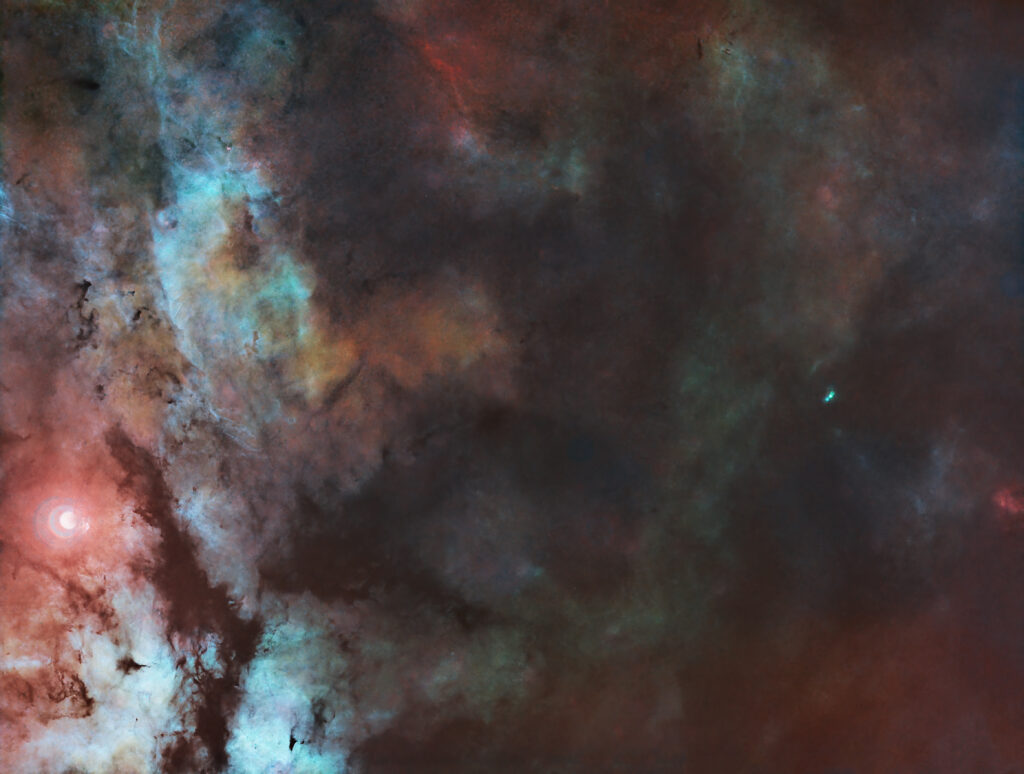
Final starry image made in Photoshop; .psd file with layers and adjustements available here > https://e.pcloud.link/publink/show?code=XZBA5WZR0XKpIdXIW08HcdAso5qckue4OV0
SHO integration
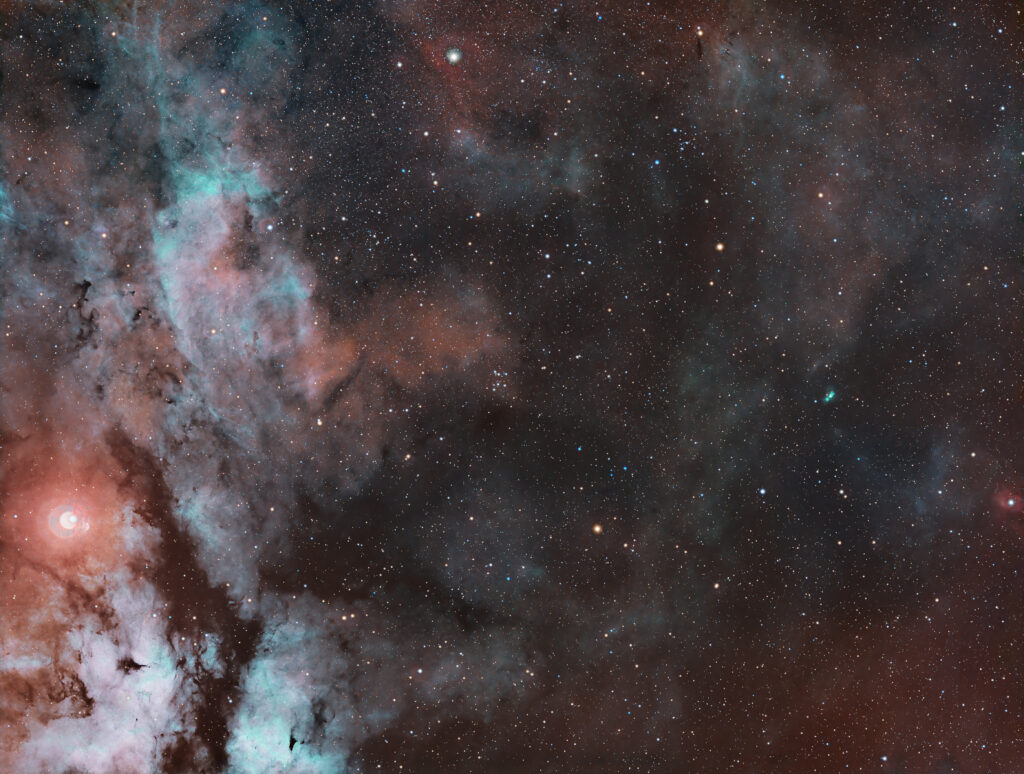
Ha Oiii Hbeta integration
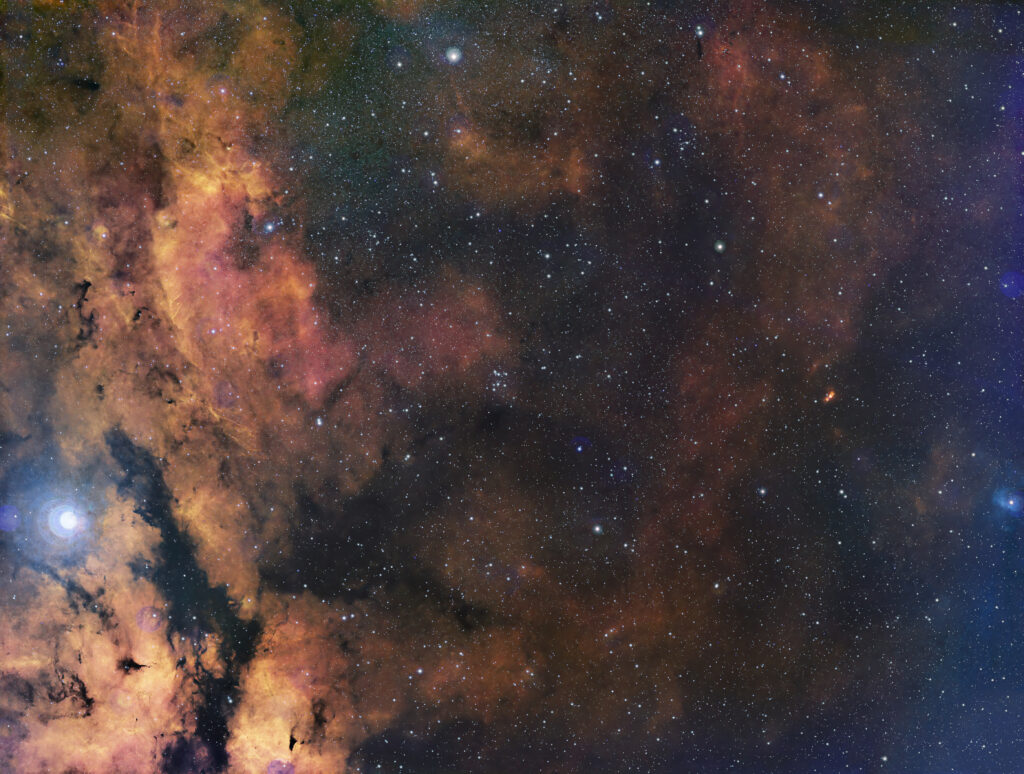
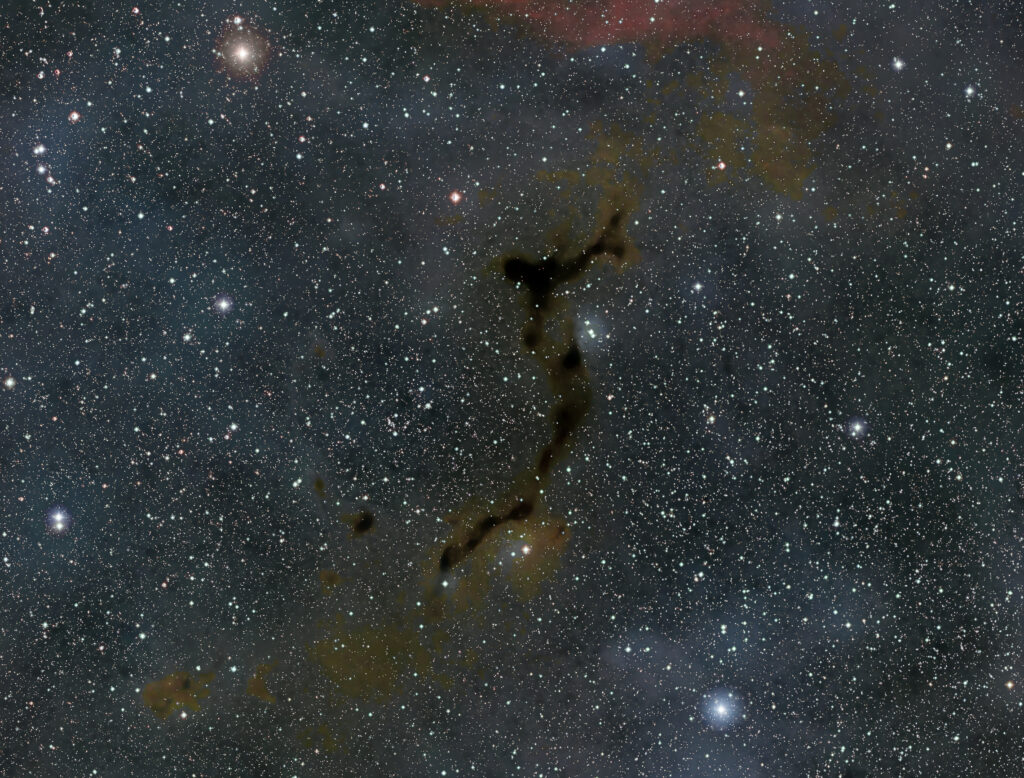
Barnard 150 “Seahorse” nebula in LRGB, from Almeria (Spain) Takahashi FSQ-106EDX4 (106 mm) F3.6 with CCD Proline FLI PL16083; 600″ subframes.
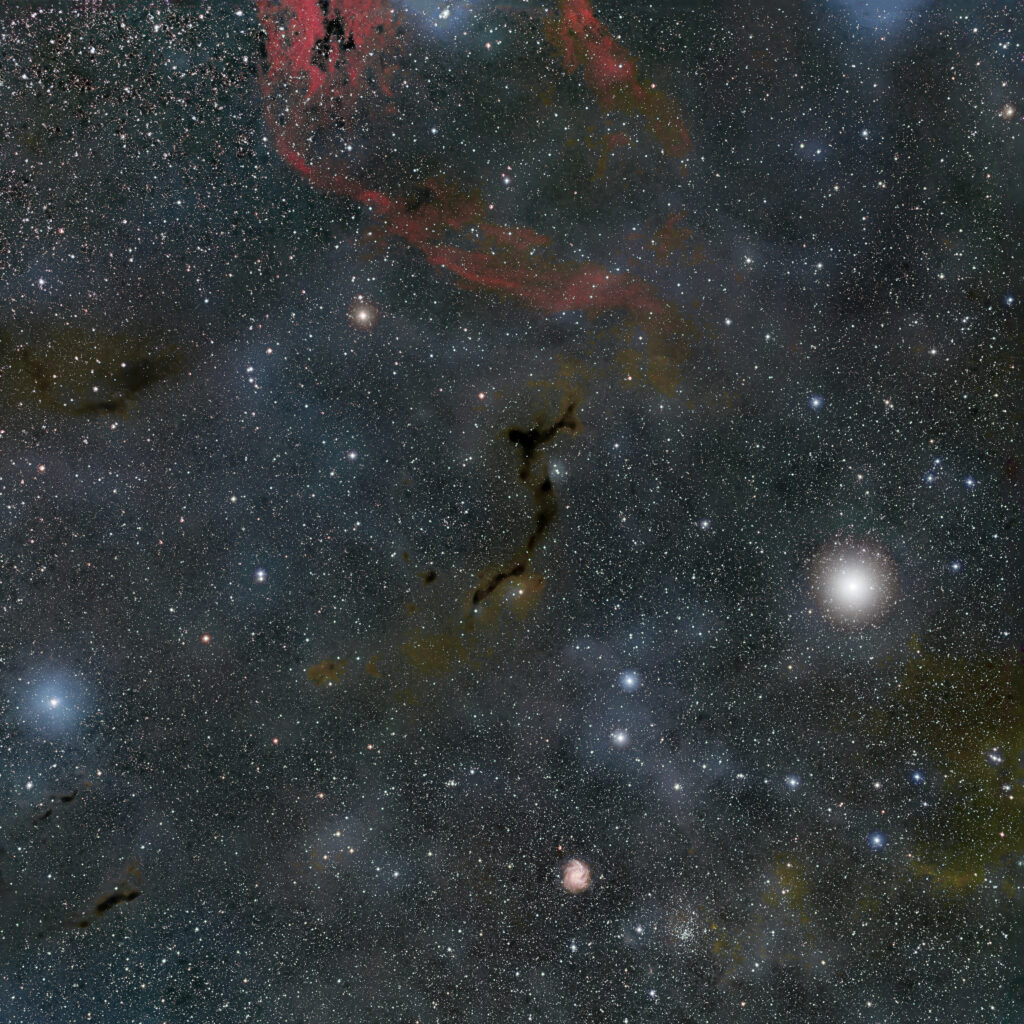
Amazing wider field view includes many DSO objects.
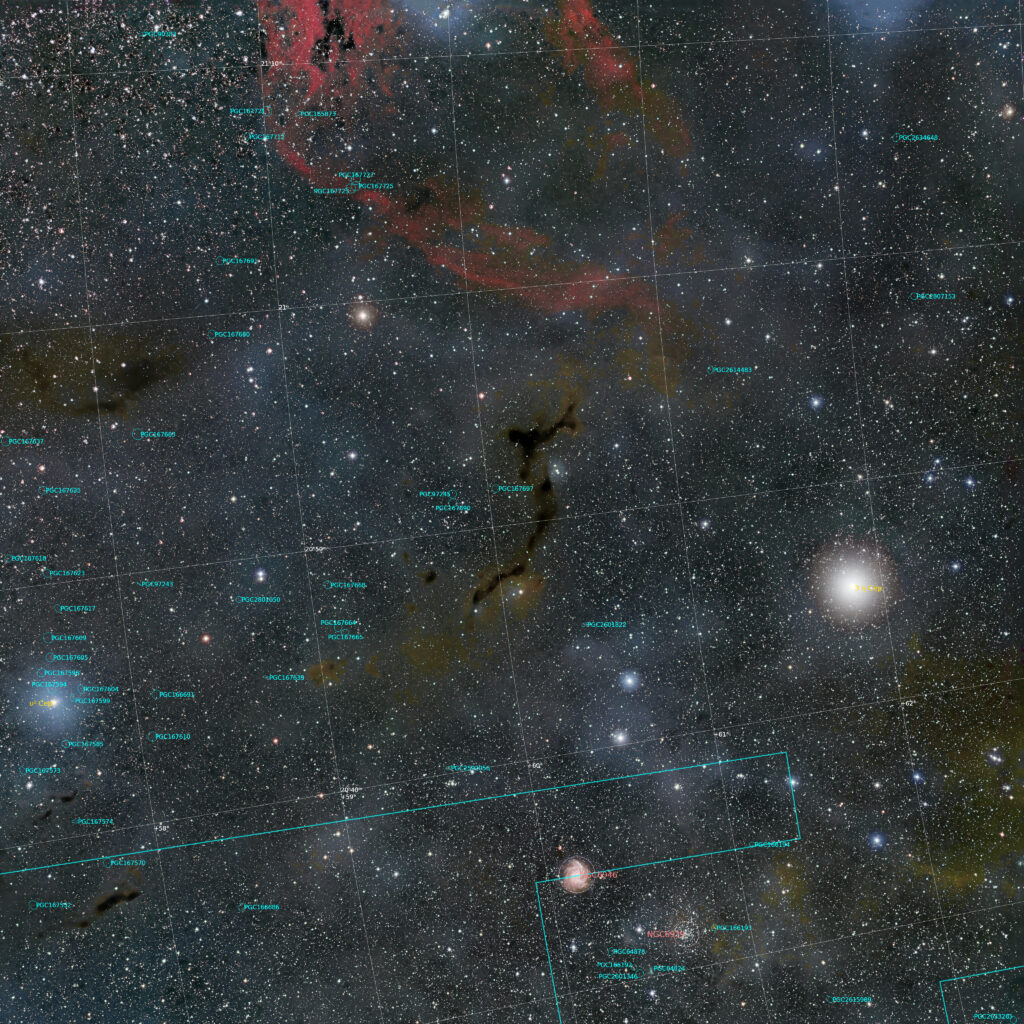
Annotated wider field view shows PGC galaxies and details.
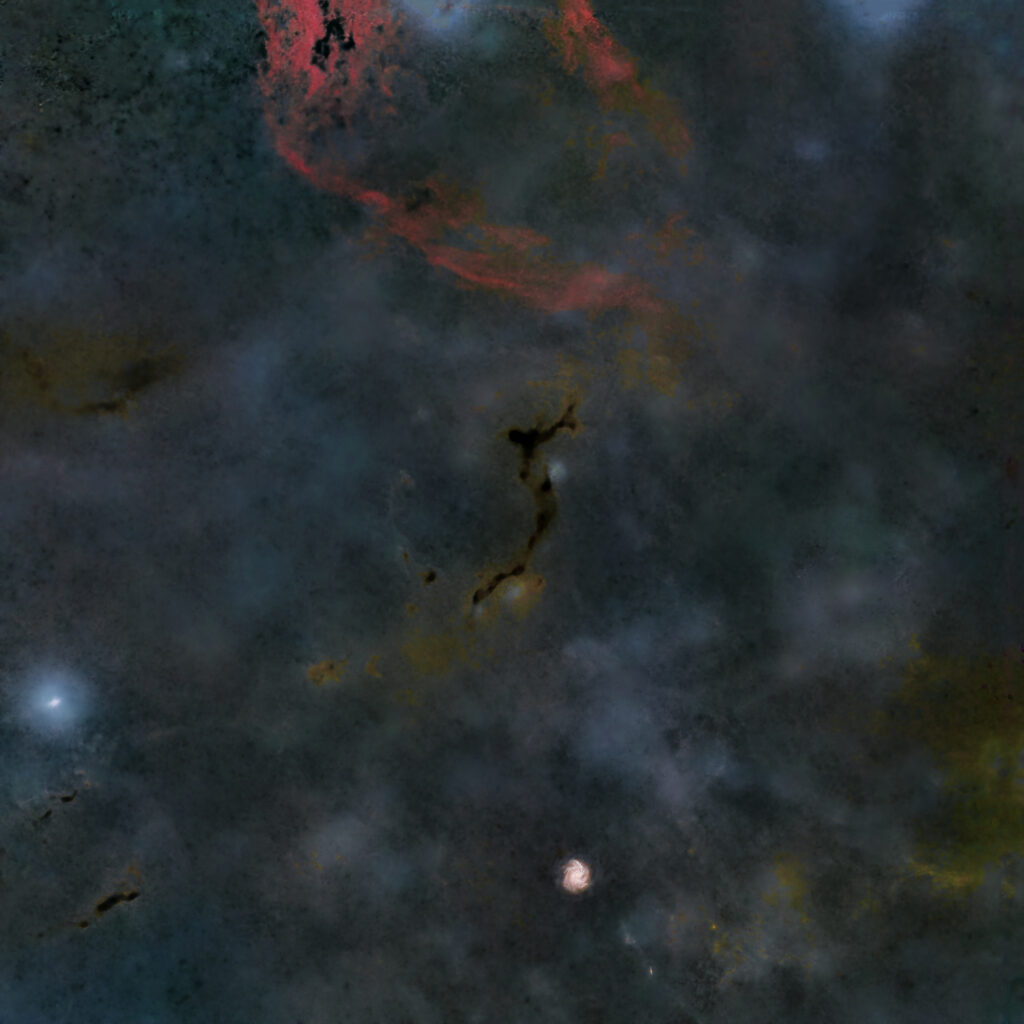
Starless stage of image post production before Photoshop reassebling reveals nebulosity complex details and structures.
After cosmetic correction of calibrated data, I processed subframes within star registration and integrated each channel. LRGB channel combination gave the starting point master. It was processed into dynamic BG removal and after platesolving colors were calibrated by SPCC.
Deconvolution and denoise followed to thus apply color masks for a first enhancement of colors and contrast first to the whole starry file, thus to starless and stars separated flows for better result.
Final composition of image made in Photoshop; original .psd with layers groups and adjustement here available.
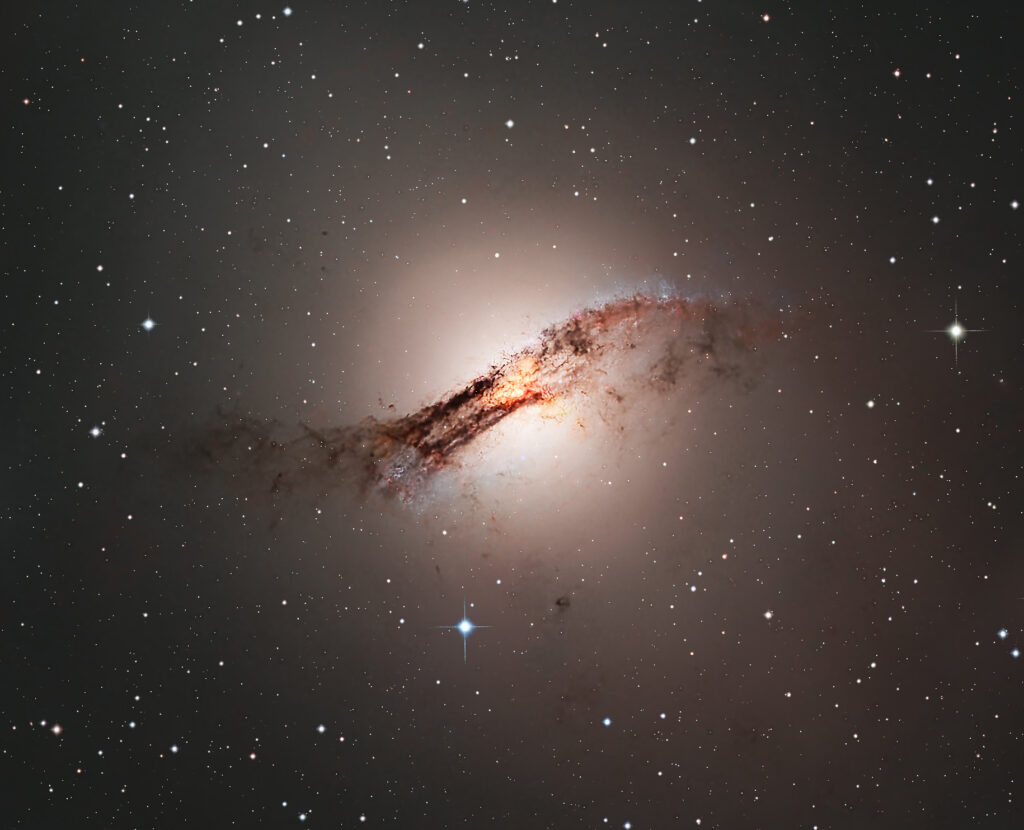
LRGB integration for Centaurus Alpha galaxy, Planewave CDK24 and Proline FLI PL9000, in the Rio Hurtado Valley of Chile, Telescopelive network.
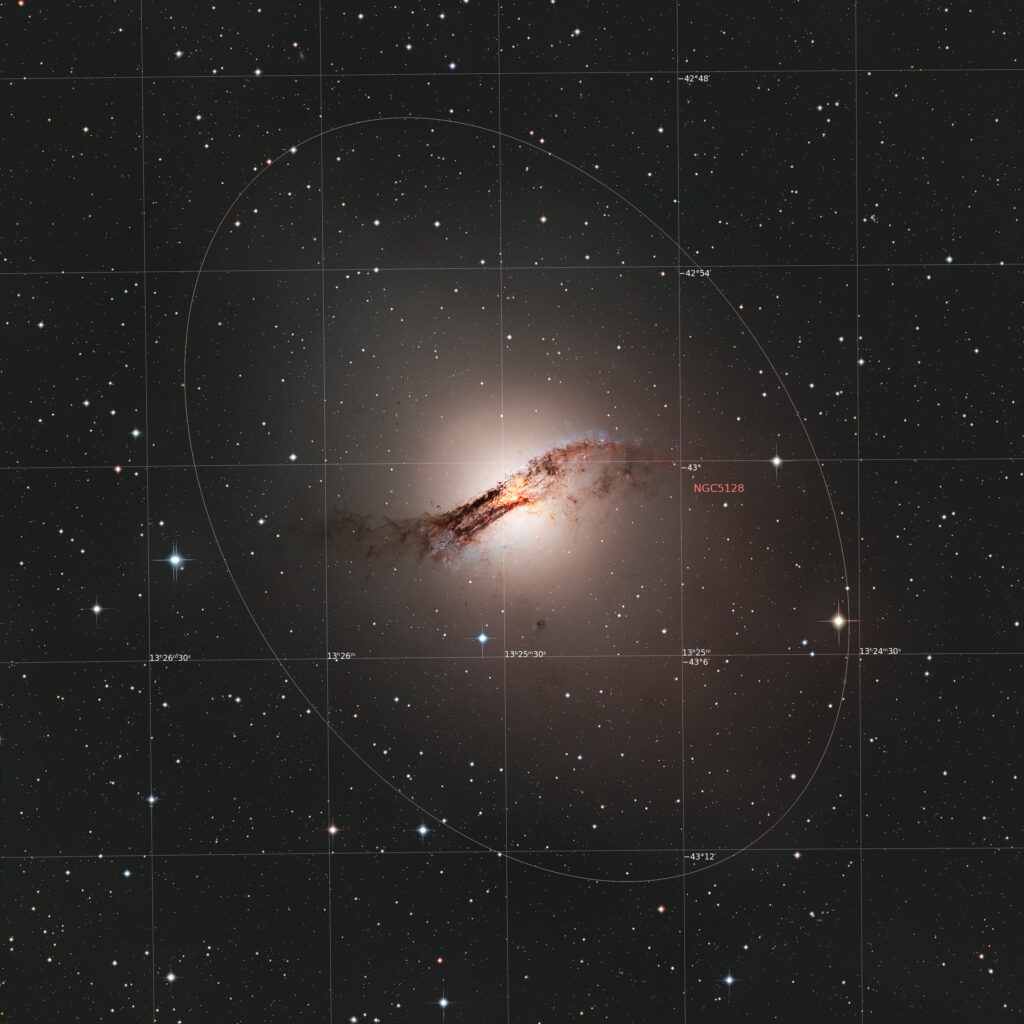
Annotated wider field integration.
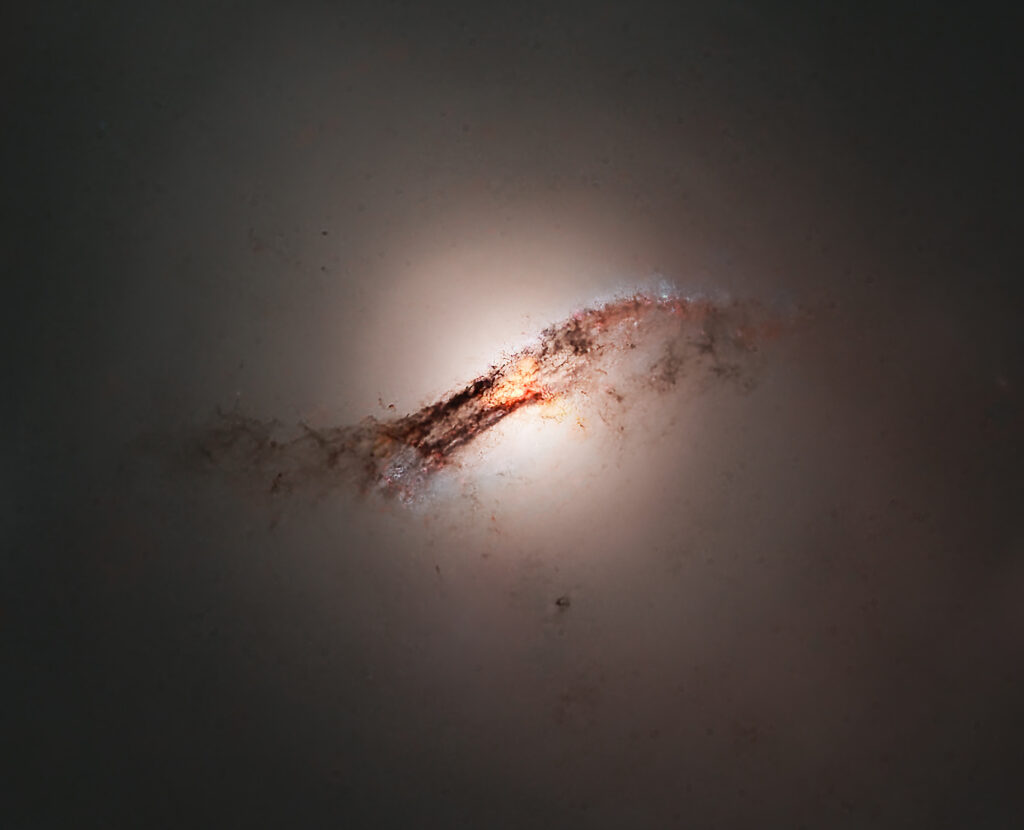
Starless stage of cropping focused on galaxy
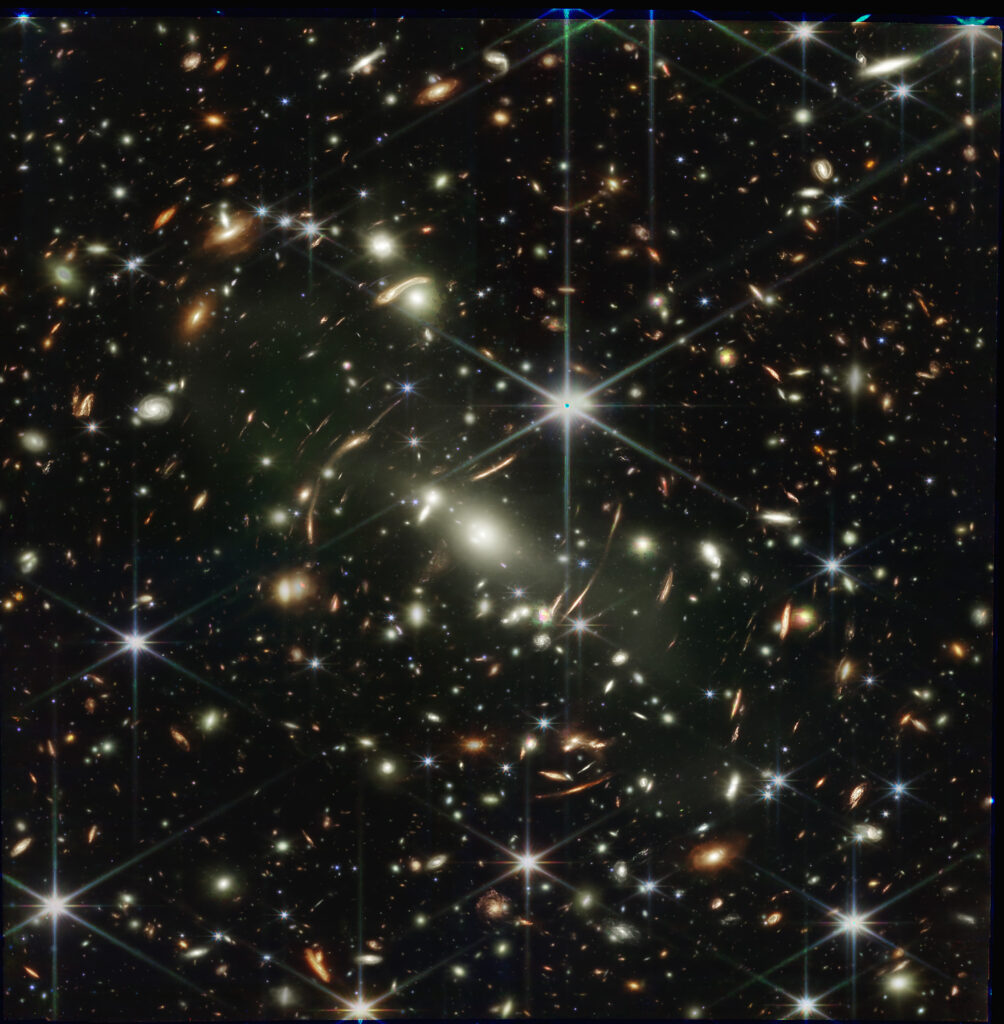
A gravitational lens, as predicted by Einstein general theory of relativity, is a distribution of matter or a point particle between a distant light source and an observer, and such matter is capable to bending light from the source as light travels toward the observer, and although Einstein made unpublished calculations in 1912, Khvolson 1924 and Link 1936 officially first discussed the effect of gravitational lens, however the official study is more commonly associated to Einstein 1936.
Cfr. : Khvolson O. 1924 : Über eine mögliche Form fiktiver Doppelsterne “ in Astronomische Nachrichten 221 (20): 329-330
Einstein A. 1936 “Lens-like action of a star by the deviation of light in the gravitational field” in Science 84 (2188):506-507
Unlike an optical lens, a point-like gravitational one produces as maximum deflection of light as the closest light passes to its center, and a minimum furthest from it, consequently scholars commonly agree that such gravitational lens has no focal point but focal line.
Observations in fact demonstrated that if the light source, the massive matter acting as a lens, and the observer all lie in a straight line, the original source will appear as a ring around the massive lensing object named “Einstein ring”, or “Einstein–Chwolson ring” or “Chwolson ring “: ring effect was first mentioned in the academic literature by Orest Khvolson in previously mentioned article of 1924, in which he mentioned the “halo effect” of gravitation when the source, lens, and observer are in near-perfect alignment.
Misalignment between the observer, matter lens and source of light will be appreciate by observer like an arc segment.
Ring-like structure, size, and family of multiple source of light geometry observation and measurement:

The geometry of a complete Einstein ring, caused by a gravitational lens with the size given by the Einstein radius.
Micro lensing techniques have been used to search for planets outside our solar system, as for instance according to Cassan et al. 2012 statistical analysis of specific cases of observed microlensing over a period of 2002 to 2007 found that most stars in the Milky Way galaxy hosted at least one orbiting planet within 0.5 to 10 astronomical units.
Cfr. Cassan A. , Kubas D. , Beaulieu J. , Dominik M. , Horne K. , Greenhill J. , Wambsganss J. , Menzies J. , Williams A. 2012 “One or more bound planets per Milky Way star from microlensing observations” in Nature 481 (7380):167-169
Galaxy cluster
According to Atek et al. 2015 galaxy clusters can be considered as the most massive structure in actual known Universe and are therefore powerful cosmic instruments for observing faint and distant sources via gravitational lensing effect.
As indicated by Caminha et al. 2016b and by Vanzella et al. 2020, 2021, lensing magnification obtained by observing trough galaxy cluster can reach factors of ~ 100 – 1000, as when a background source of light, i.e. a galaxy, lies between observer and galaxy cluster, light rays from the sources are deflected by gravitational potential of the foreground cluster; source is thus gravitationally lenses by the cluster.
Moreover, as suggested by Bradač et al. 2006 and by Clowe et al. 2006, position and morphologies of multiple lensed images also allow to speculate about the distribution of matter, particularly dark matter, in the galaxy cluster, crucial topic for understanding nature of dark matter.
Julio et al. 2010, Acebron et al. 2017, Caminha et al. 2016a and 2022 pushed further, as an individual galaxy cluster often lenses several background sources into several corresponding “families” of multiple images that straddle different locations around the galaxy cluster, and families of multiple images formed by sources in different redshift provide possible measurements of angular diameter distance ratios between cluster and source, allowing researchers to focus about the study of the geometry of the universe.
Refsdal 1964; Suyu et al. 2010; Kelly et al. 2015; Grillo et al. 2018 and 2020 believe that strong lensing galaxy clusters are therefore excellent laboratories for astrophysical and cosmological studies as in case where a background source is timy-varying, as a quasar or a supernova, the time delays between multiple images study provides to speculate measurements of the “time-delay distance” and the Hubble constant that sets the expansion rate of actual known Universe.
According to Rigby et al. 2022, James Webb Space Telescope operating in infrared provides unprecedented observation of high-redshift sources in terms of sensitivity and angular resolution.
Combination of JWST capacities and galaxy cluster lensing consent to observe inherently faint sources like distant galaxies which are the first formed and which evolved into structures that we see today.
Among these targets JWST focused on its first cosmic target to galaxy cluster SMACS J0723.3-7327 discovered by Ebeling et al. 2001 and Repp & Ebeling 2018.
According to Caminha et al. 2022 JWST observations practically doubled number of families of multiple images previously detected by Hubble Space Telescope.
Hubble observations of SMACS J0723 cover an area of 3.36 arcmin x 3.36 arcmin and were obtained by f435w, f606w and f814w filters of ACS – Advanced Camera for Surveys, and in f105w, f125w, f140w and f160w of WFC3 – Wide Field Camera 3 all available and retrieved at Mikulski Archive.
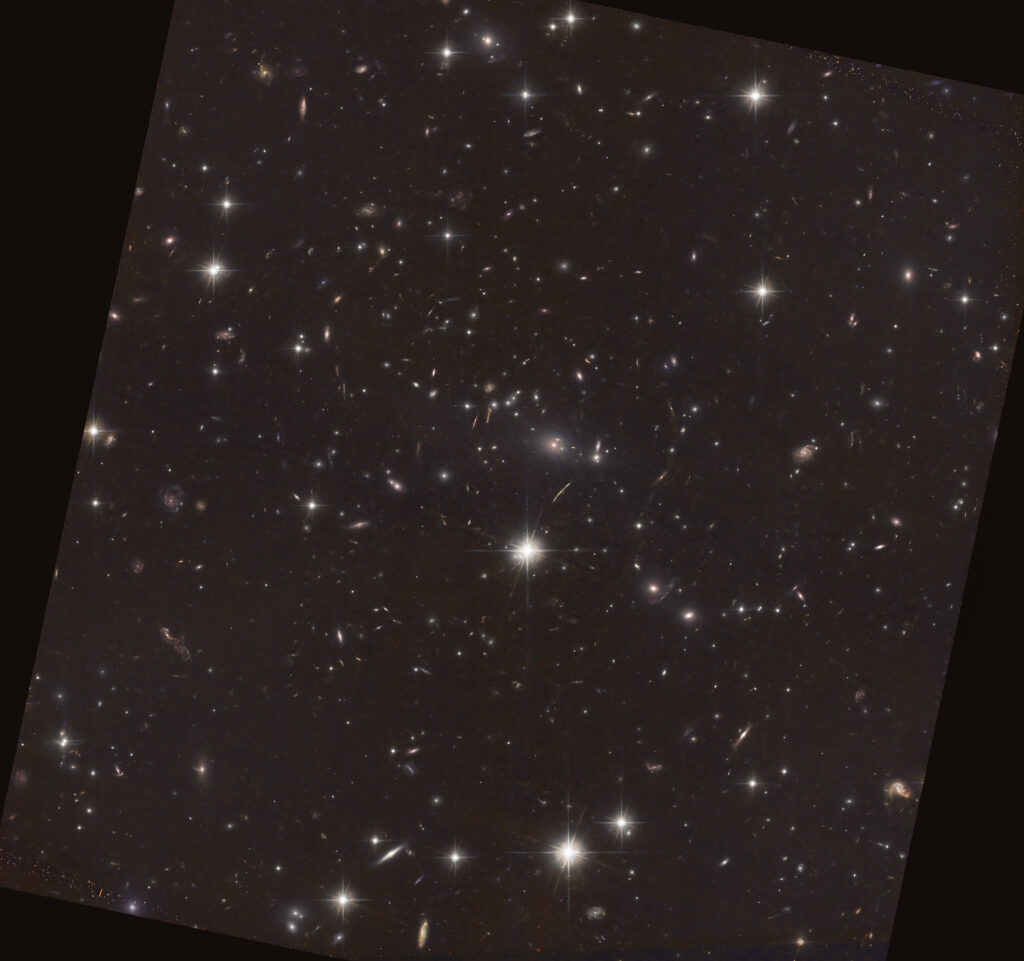
Caminha et al. 2017b, 2019 and 2022 produced by Hubble data plus MUSE data of SMACS J0723 a final redshift catalogue containing 78 secure and precise redshift measurements.
SMACS J0723 was observed by James Webb scope by Near Infrared Camera – NIRCam and MIRI – Mid-Infrared Instrument and spectroscopy was obtained trough the NIRSpec – Near Infrared Spectrograph.
According to Pontoppidan et al. 2022 and Méndez-Abreu et al. 2023, with a single filter total exposure of about 7.500 seconds divided in nine dither patterns to optimize image quality NIRCam records were taken on 2022 June 7th, carried out in filters f090w, f150w, f200w, f277w, f356w and f444w, covering a wavelength range between 0.8nm to ~ 5.0nm.
Webb scope NIRCam FoV observes a 9.7 arcmin 2 (al quadrato) field with a ~44 arcsec gap separating two 2.2 arcmin x 2.2 arcmin areas, with one camera centers on the cluster and another on an adjacent field, covering a smaller area of J0723 respect to Hubble imaging.
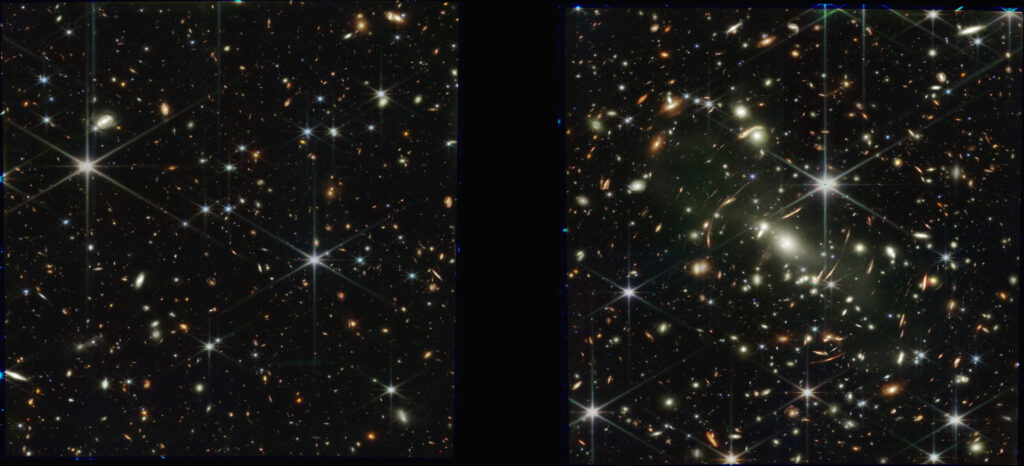
According to Caminha et al. 2022, Webb Scope NIRCam wavelengths and high spatial resolution records, aligned to HST data took to identify new 30 additional secure multiple images from 11 individual sources, extremely faint or not detected in the Hubble optical and near infrared imaging, whilst Before the release of James Webb scope NIRCam imaging of SMACS J0723 dataset available from Hubble plus photometry from RELICS program and spectroscopy from MUSE identified 23 cluster members in the redshift range of 0.367 – 0.408 corresponding to a rest-frame velocity of + – 3000 km/s from the cluster mean redshift of z=0.387; these pre JWST studies evinced according to Caminha et Al. 2022 in 19 multiple images as input from six families.
In conclusion, Webb scope actual studies of NIRCam records focused about SMACS J0723 scholars have doubled the number of model constraints, increasing the number of multiple images from the 19 identified with Hubble and MUSE datasets to 49.
According to Méndez-Abreu and colleagues 2023 observations obtained by NIRCam provides new data in the study of the evolution of barred galaxy, as the central role of stellar bars in the secular evolution of galaxies discs is generally accepted: as founded by Hubble 1926 and Buta et al 2015 they represent the main structure modifying the morphology of galaxies in the central ~ kpc and according to Debattista & Sellwood 2000, Martinez-Valpuesta et al. 2007 and Sellwood 2014 they influence the angular momentum redestribution between the baryon of and dark matter component of galaxies.
Evolution of the bar fraction with cosmic time has been matter of several studies due to its implications on the settlement of the first rotationally dominated discs. According to Sellwood 2014 and Méndez-Abreu 2023 bars can be formed spontaneously in cold galaxy discs in a relative quick phase (<=1 Gyr) and assuming as right as they are long lived, the presence of a bar can be used as a clock to time the formation of discs.
Martinet & Friedli 1997, Sheth et al. 2005, Ellison et al. 2011 identify in galaxies bars the parts with the ability to funnel material towards the galaxy core where starburst can ignite; Kormedy & Kennicut 2004, Athansas-soula 2005, Bittner et al. 2020 with Gadotti et al. 2020, all agree that they contribute to the formation of bulge-like structures.
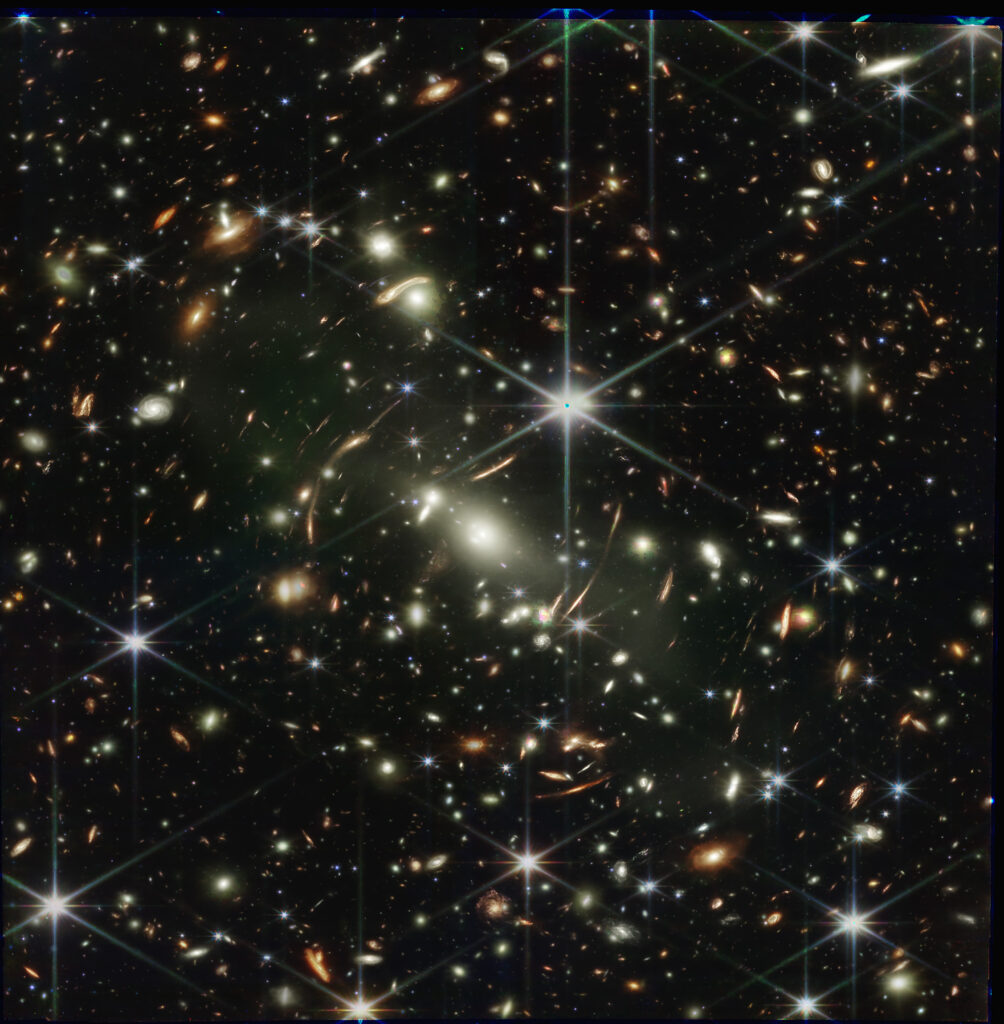
Buta 1995, Muñoz-Tuñón et al. 2004 identifies in bars the main inner star forming ring’s cause.
Importance of bars in understanding galaxy evolution is also given by their ubiquity in disc galaxies in the local Universe (z < 0.1) with actual galaxy population optical studies generally described as barred by ~50%, with slight increase by infrared observations; Cfr. Aguerri et al. 2009; sbarazza et Al. 2008, Eskridge et al. 2000, Marinova & Jogee 2007, Menéndez-Delmestre et al. 2007, Erwin 2018.
According to Méndez-Abreu and colleagues 2023 most of our knowledge about the formation and evolution of bars has been produced using local galaxy samples, and studying SMACS J0723.3-7327 galaxy cluster using the new capabilities of Webb scope coincides with the possibility of measure the fraction of barred galaxies in a cluster with redshift z=0.39, and NIRCam imaging features overcome previous problem of spatial resolution, bar identification at rest-frame wavelengths, and depth of the observations.
Méndez-Abreu et al 2023 studies for barred galaxies identification and classification started from NIRCam f200w filter integration master, with first step as identification of cluster J0723 members, consisting in 188 certain galaxies.
Identification of bars was made by Méndez-Abreu setting up a private project using the Zooniverse Panoptes Project Builder, creating .fits cutouts of cluster members and converting each one in a single arcsinh stretched frame, with the result of 20 secure barred galaxies and 15 uncertain out of 188 members.
Méndez statistical analysis shows that bar fraction distribution in SMACS J0723 cluster is a strong function of galaxy mass, results which compared with the state of art of observational and theoretical studies appears little increasing, probably dued both to different criteria in selection (angular momentum vs morphology) and improved capabilities of JWST/NIRCam respect to previous instrument in terms of spatial resolution and image depth.
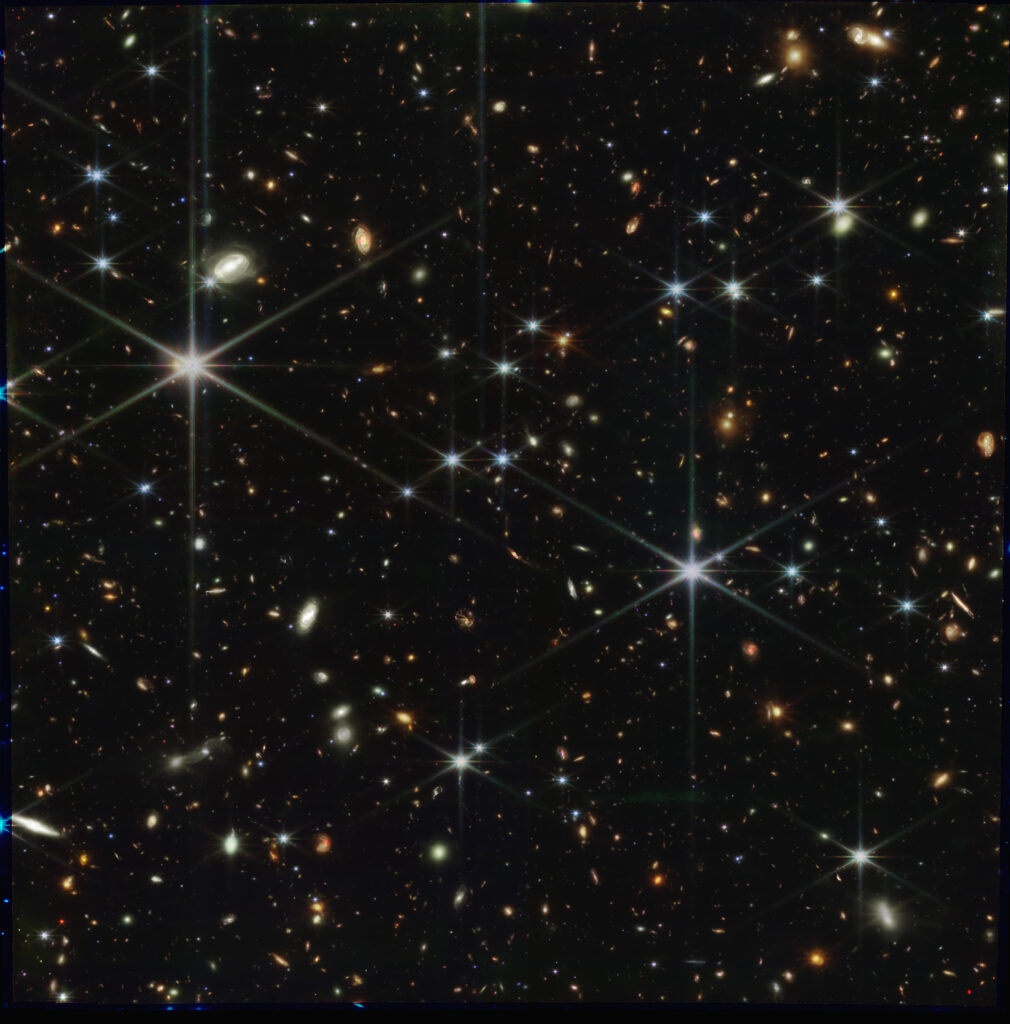
The mechanism inhibiting the formation of bars in cluster seems act relatively quickly after galaxies enter into the cluster potential, with a scenario where cluster environment affects the formation of bars in a mass-dependent way. At high masses it seems plausibile to assert a weak effect of cluster environment possibly triggering bar formation, whilst at low masses galaxies bars formation seems to be severely inhibited by cluster setting.
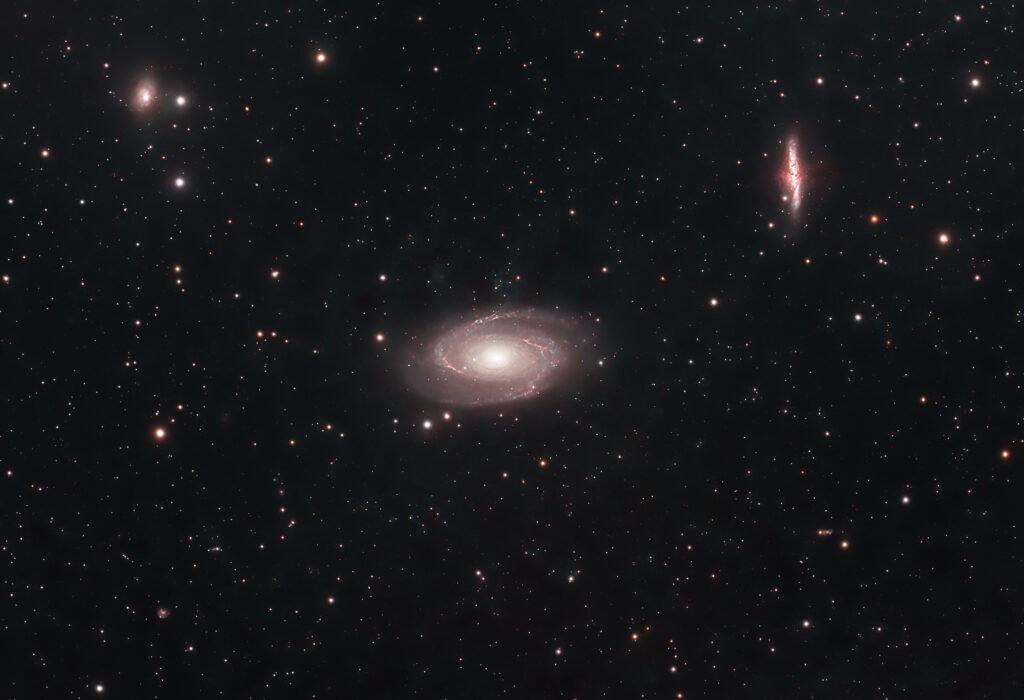
Astrobin:
During 2021 and 2022 I took a good number of subframes focusing on M81 and M82 field and I planned to integrate RGB channels with Ha and Oiii narrowband contribute.
Being a follower of John Rista short time DSO photography approach, RGB channel subframes I recorded at 60″, Halpha and Oiii subframes at 180″, William Optics Redcat51 and ASI1600mm Pro at -20 Celsius, Gain 139.
For Rista excellent studies, please cfr. https://jonrista.com/the-astrophotographers-guide/the-zwo-asi1600-guide/the-zwo-asi1600/preliminary-analysis/ and https://www.cloudynights.com/topic/578198-short-exposure-time-asi-1600mm-cool/ both on 02/08/2023.
After standard calibration, cosmetic correction by dark-master, star registration and winsorized sigma clipping integration, I obtained masterframe for each channel recorded.
Channel combination of RGB generated a good integration which I played with Ha and Oiii masters to Dynamic BG removal, solving (and annotated transparent layer version for further work), Spectrophotometric Color Calibration (just RGB) deconvolution and denoising.
I then proceed by starXterminator in starless and stars version of each master to work properly ‘till putting them back by PixelMath, obtaining a pretty good RGB master
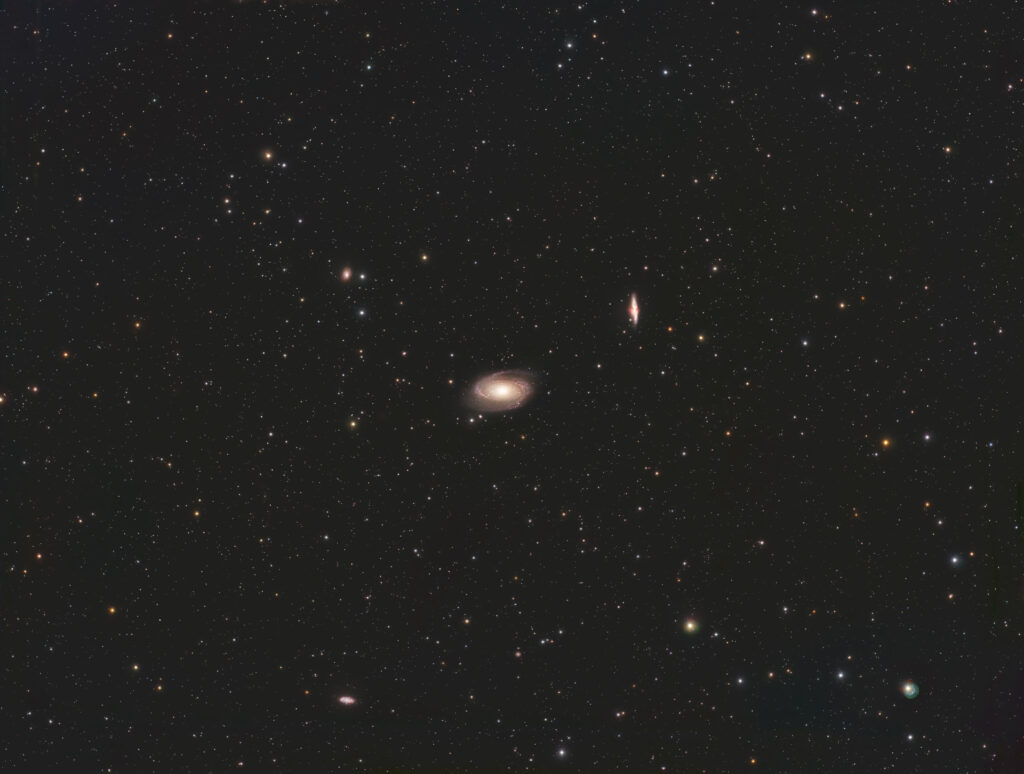
with ready-to-go Halpha and Oiii narrowband master to integrate within:
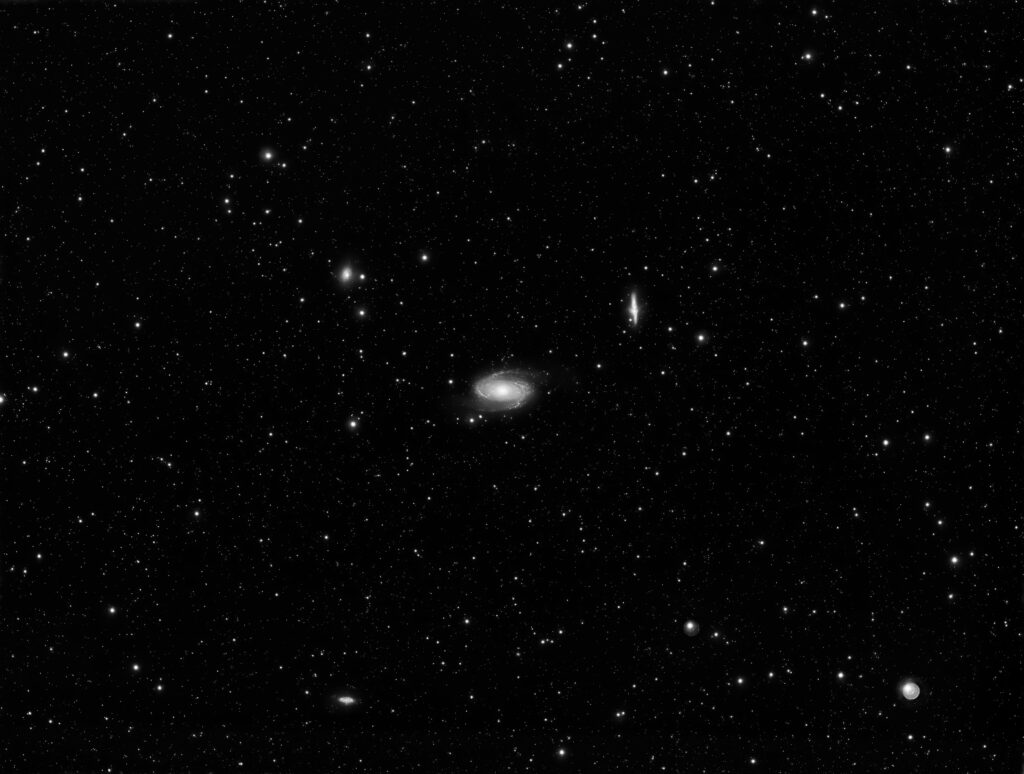
H alpha channel to be associated to R channel while Oiii to differently be integrated with both G and B channels.
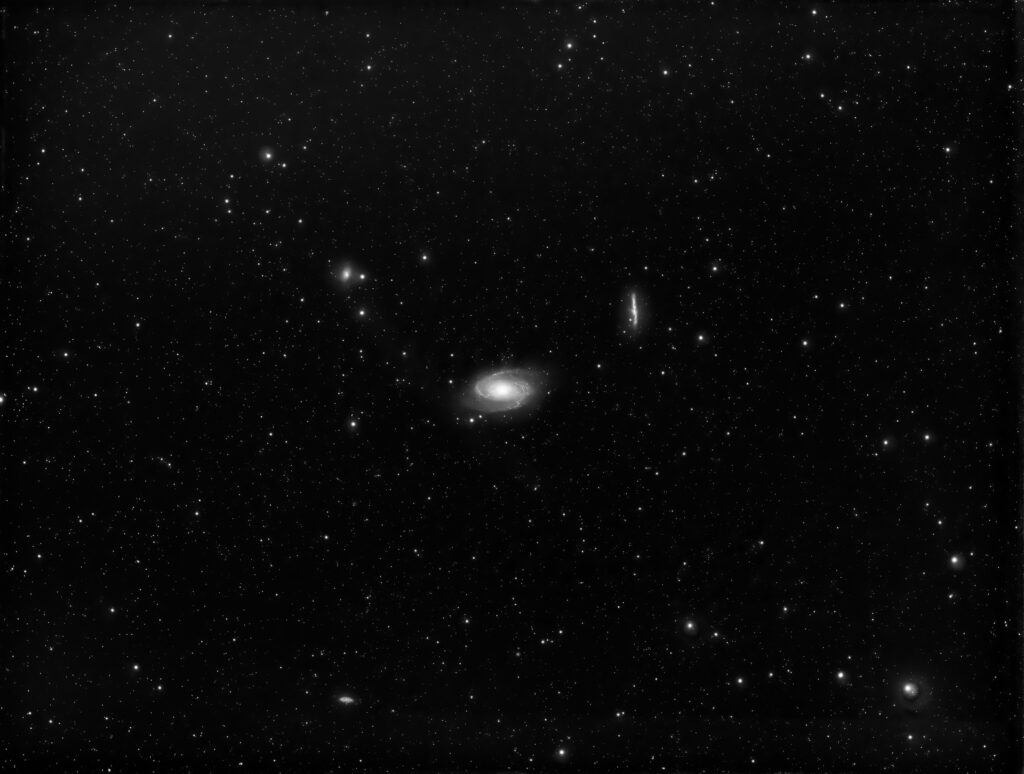
Narrowband with RGB integration produced a pretty good result which, in turns, I little worked over separating again stars and starless sub-master, finally directly melted in Photoshop.
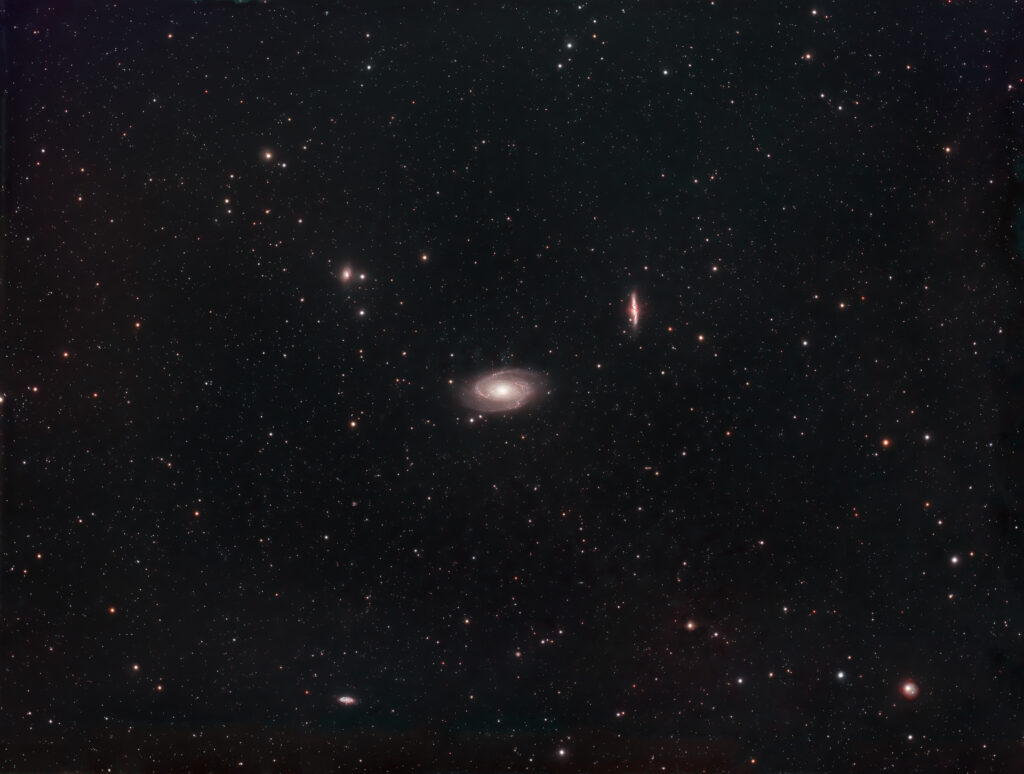
This portion of sky is so rich of galaxies; PGC annotation (PixInSight) gives an idea of the richness of field
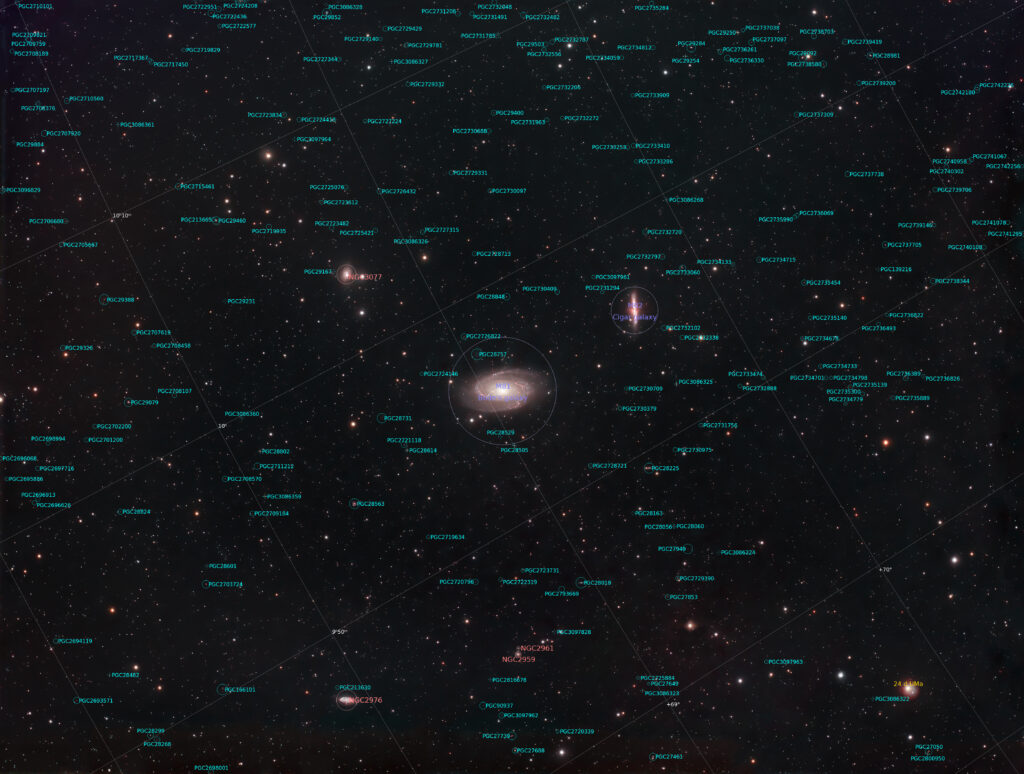
I thus start to try some crop solution for better framing and focusing the final image. At first I cropped a squared and a vertical version to catch in the field also NGC2976, NGC2961 and NGC2959.
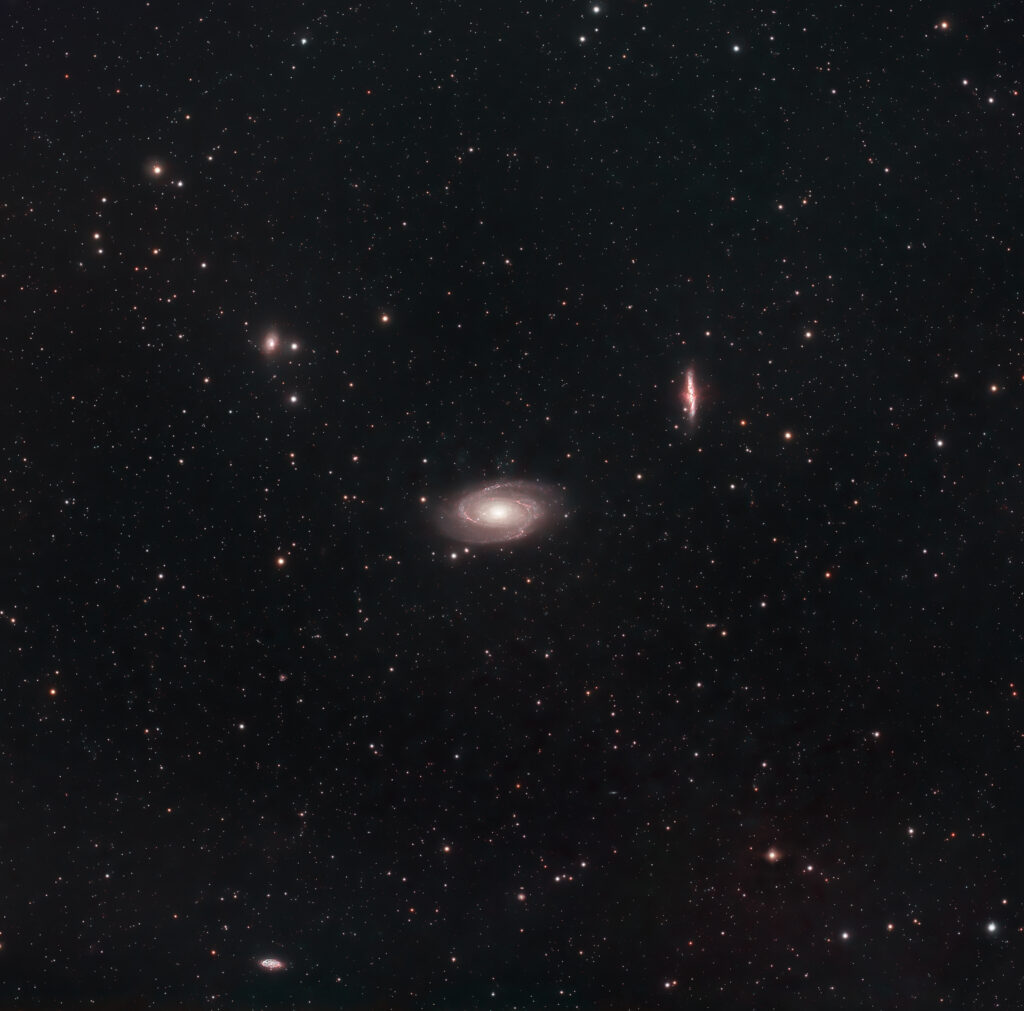
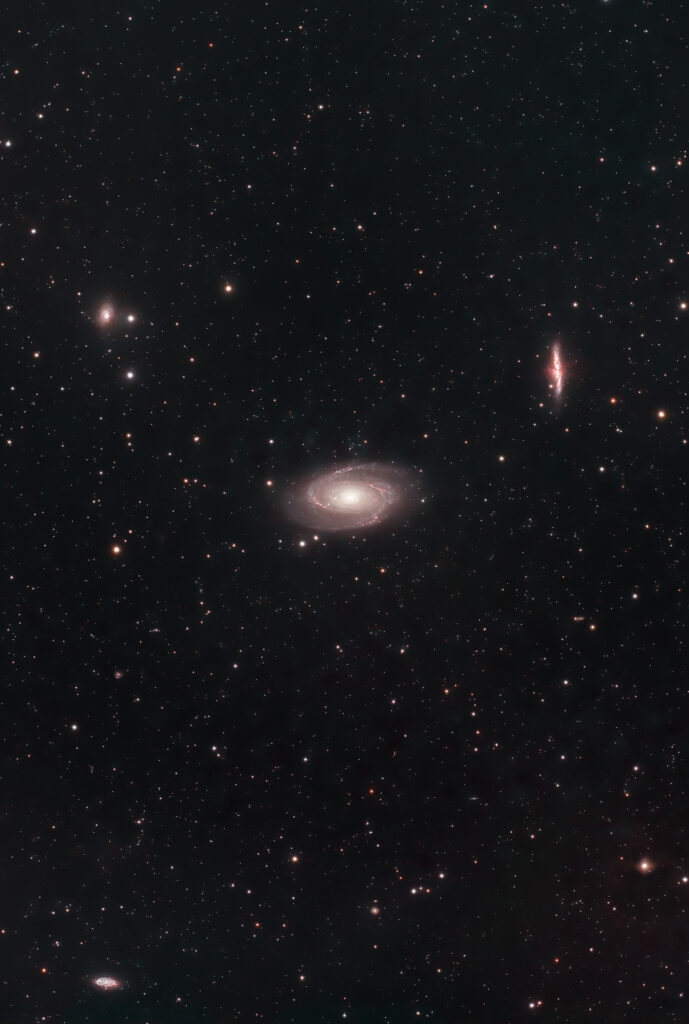
Finally I focused about M81 and M82 with a deep cropping for an orizontal composition, trying to dispose M81 and friends according to 3/4 grids basic composition rule.
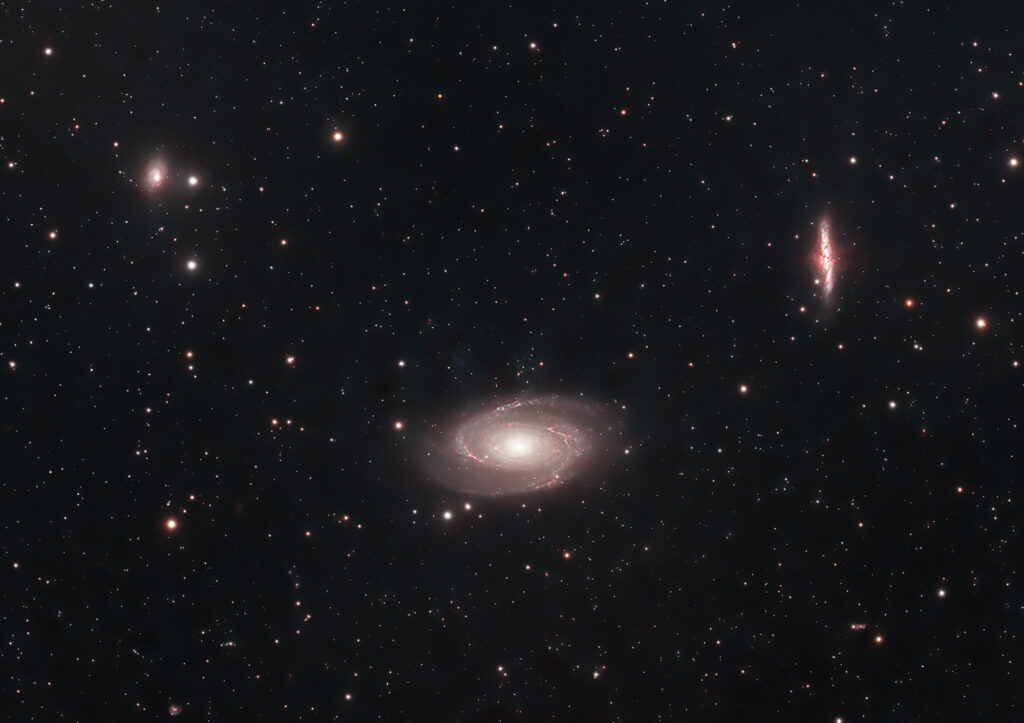
Photoshop, non cropped version, with 3 main crops framing as guide layer are available here
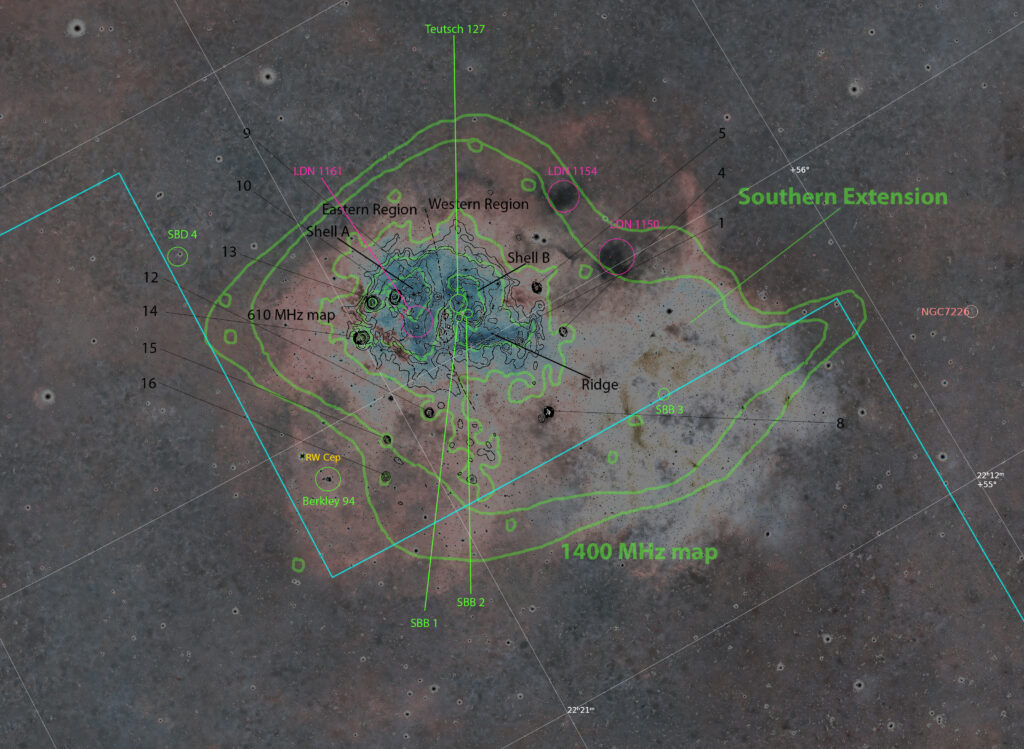
According to Stewart Sharpless annotation, 1959 “A Catalogue of Hii Regions” U.S. Naval Observatory, 10 Sept. 1959 [ https://articles.adsabs.harvard.edu/pdf/1959ApJS….4..257S ], Sh2-139 is “Part of II Cep association” a wide and luminous OB spectral type stellar association situated at a distance of about 3.200 parsec, or 10.400 light years, within the Perseus Arm, one of the 2 major spiral arms of our galaxy.
Cfr.: Churchwell Ed, Babler Brian L., Meade Marlin A. 2009 “The Spitzer/GLIMPSE Surveys: A New View of the Milky Way” Publications of the Astronomical Society of the Pacific. 121: 213–230. https://ui.adsabs.harvard.edu/abs/2009PASP..121..213C/abstract
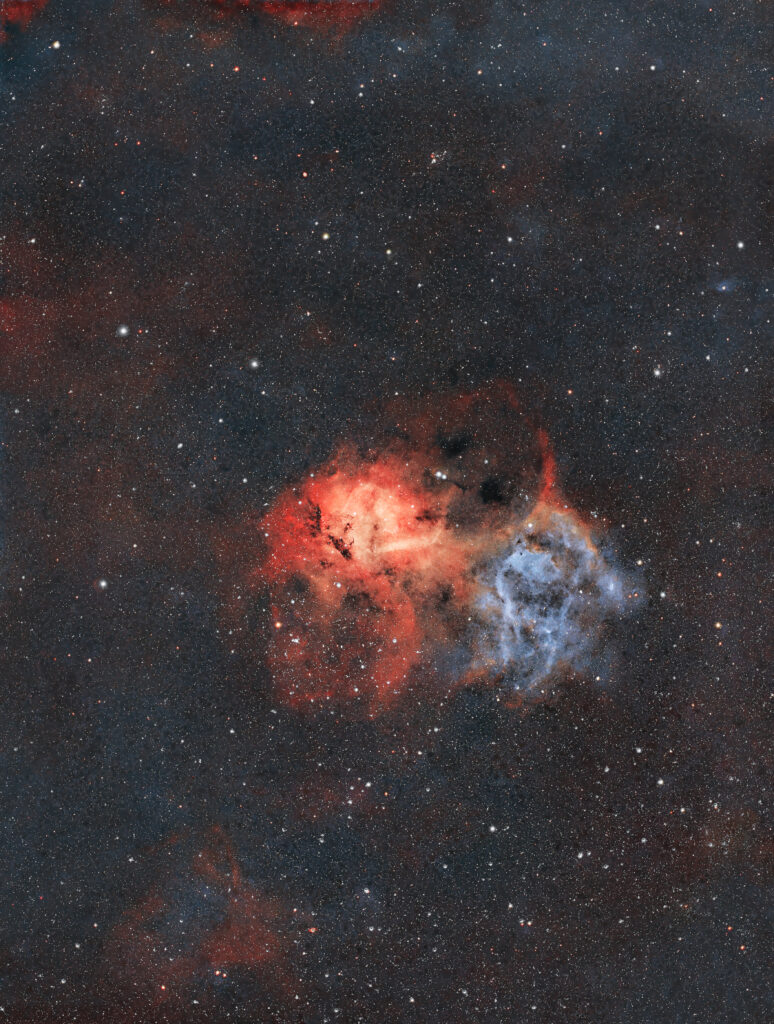
Sh2-132 complex is featured by a bright optical nebula with an intense central region (Ø = 25’) surrounded by more diffuse emission ( Ø ~ 1*). Low resolution radio studies have shown it to be an intense radio source with a strong central core contained into a more diffuse envelope.
Churchwell and Walmsley 1973 analysis confined that the total emission is thermal nature, featured by a spectrum flatted down to 0.408 GHz, typical of a low Hii density region.
Cfr. Churchwell E. , Walmsley C. M. , 1973 “Observation of Optical Nebula at 2695 Mhz ” in Astron. Astrophys. 23: 117
Nebula analysis shows two distinct regions separated by an area, running from NW to SE, with little or no emission.
The optical emission in the eastern region is quite mottled, with areas of bright emission and patches of obscuring materials. Western region is instead featured by little or no obscuring matter.
According to Lynds 1962 Catalogue of Dark Nebulae there are three main dark nebulae classified as LDN 1150, LDN 1154 and LDN 1162; Cfr. https://heasarc.gsfc.nasa.gov/W3Browse/nebula-catalog/ldn.html
Strong central features and western/eastern regions strong/weaker emission are confirmed by radio analysis at 0.408 GHz and 1.4 GHz conducted respectively by Felli et al. 1977a and Felli and Churchwell 1972.
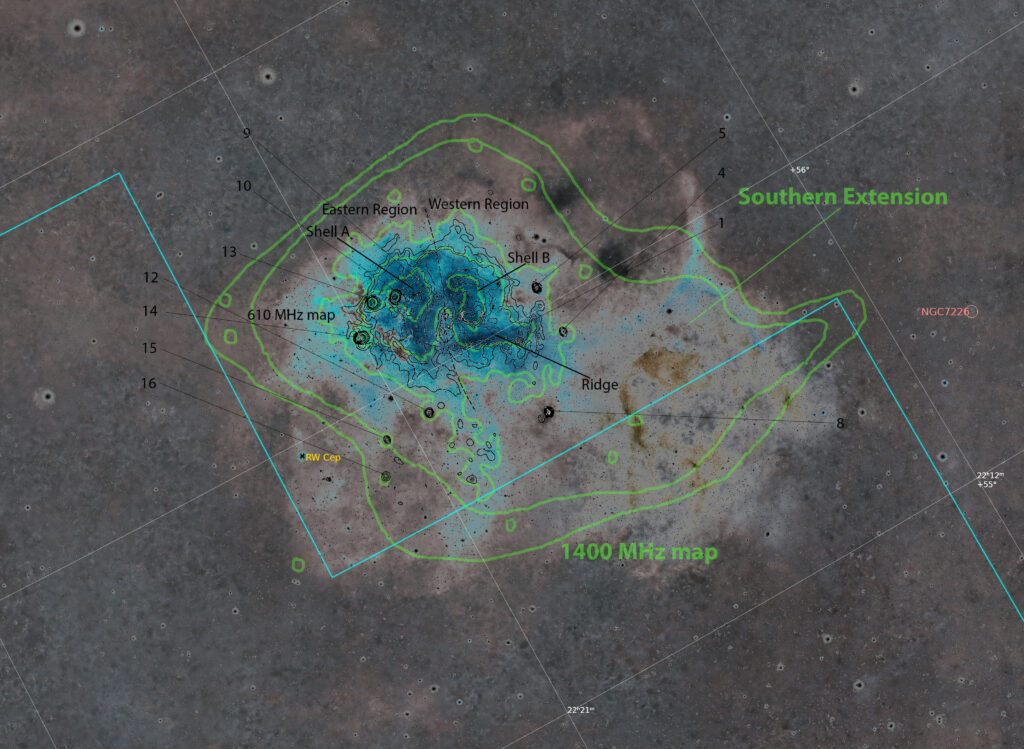
According to Van der Hucht 2001 and Hamman et al. 2006 among those very hot and massive stars responsible for the ionization of gasses, notable consideration have to be taken about two Wolf-Rayet subjects, known as HD 211564 and HD 211853 (or WR 153), featured by a huge bubble well visible in radio emissions identified as Shell B, which scholars suggest to be originated from strong stellar wind from these massive star, featured after Harten et al. 1978 study by a non uniform emission specially on the eastern side where there is essentially no emission at all.
Similar smaller structure, named Shell A, bubbles around a class K star.
Cfr. Van der Hucht K. A. , 2001 “VizieR Online Data Catalog: 7th Catalog of Galactic Wolf-Rayet stars” in NewAR,45, 135. https://ui.adsabs.harvard.edu/abs/2001yCat.3215….0V/abstract
Hamann W. R., Gräfener G. , Liermann A. , 2006 A&A,70, 205. https://ui.adsabs.harvard.edu/abs/2006A%26A…457.1015H/abstract
According to Dubout-Crillon 1976 catalogue, lion’s bottom and tail shaped like portion is made by a thin strip of emission extending to the south of the eastern region featured by a faint Halpha ridge.
Cfr. Dubout-Crillon R. 1976 “H II regions of the northern Milky Way: medium-large-field photographic atlas and catalogue” in Astronomy and Astrophysics, Suppl. Ser., Vol. 25, p. 25 – 54. https://adsabs.harvard.edu/full/1976A%26AS…25…25D
According to Avedisova 2002 it is plausible to hypothesize that this nebula was setting of some chain processes of star origin.
Avedisova, V. S., A Catalog of Star-Forming Regions in the Galaxy, in Astronomy Reports, vol. 46, n. 3, marzo 2002, pp. 193-205. https://ui.adsabs.harvard.edu/abs/2002ARep…46..193A/abstract
Harten et al. 1978 studies of radio emission of this Hii region results indicated that 2/3 of the radio emissions originates in features larger then 10’ in diameter, suggesting that total mass and low electron density placed Sh2-132 as a member of evolved giant Hii region.
Helou and Walker studies of infrared sources identified and cataloged within the nebula nine sources of infrared radiation, while Wouterloot and colleagues 2013 identified an H2O maser source.
Helou, George; Walker, D. W., Infrared astronomical satellite (IRAS) catalogs and atlases. Volume 7: The small scale structure catalog, in Infrared astronomical satellite (IRAS) catalogs and atlases, vol. 7, 1988, pp. 1-265. https://ui.adsabs.harvard.edu/abs/1988iras….7…..H/abstract
Wouterloot, J. G. A.; Brand, J.; Fiegle, K., IRAS sources beyond the solar circle. III – Observations of H2O, OH, CH3OH and CO, in Astronomy and Astrophysics Supplement Series, vol. 98, n. 3, maggio 1993, pp. 589-636. URL consultato il 21 marzo 2013. https://ui.adsabs.harvard.edu/abs/1993A%26AS…98..589W/abstract
The development of infrared astronomy gives chances to scholars like Saurin and colleagues 2009 to explore Sh2-132 Hii regions and studied its Hii region as a star forming region and embedded star clusters complex.
Grounding on Harten et al. 1978 radio continuum emission as indication of giant nature of this complex and its evolved character, Saurin hypothesized that Sh-132 could be suitable laboratory for early dynamical and hydrodynamical evolution, and by R-band Digitalized Sky Survey imaging of the whole complex they confirm 2 previous identified open cluster

And discovered 4 new open cluster:
Cfr. Saurin T. A. , Bica E. , Bonatto C. , 2010 “Star clusters in the Sh2-132 complex: clues about the connection between embedded and open clusters” in journal of Royal Astronomical Society, 407, 133-143 (2010) https://academic.oup.com/mnras/article-pdf/407/1/133/3067396/mnras0407-0133.pdf
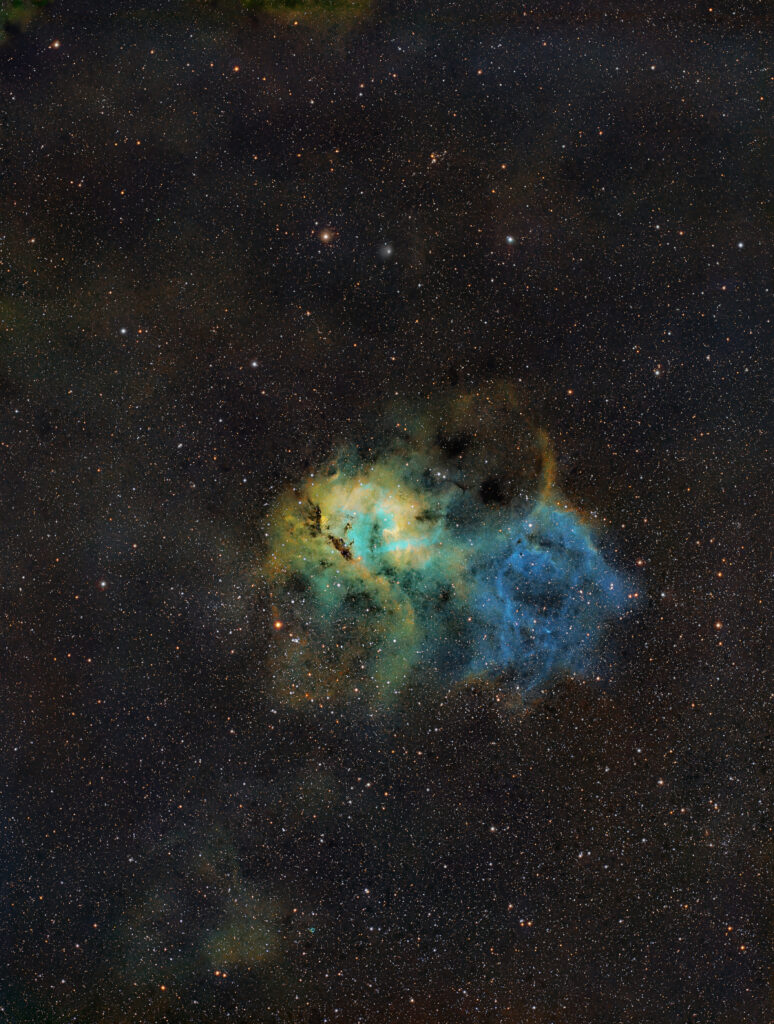
Astrobin:
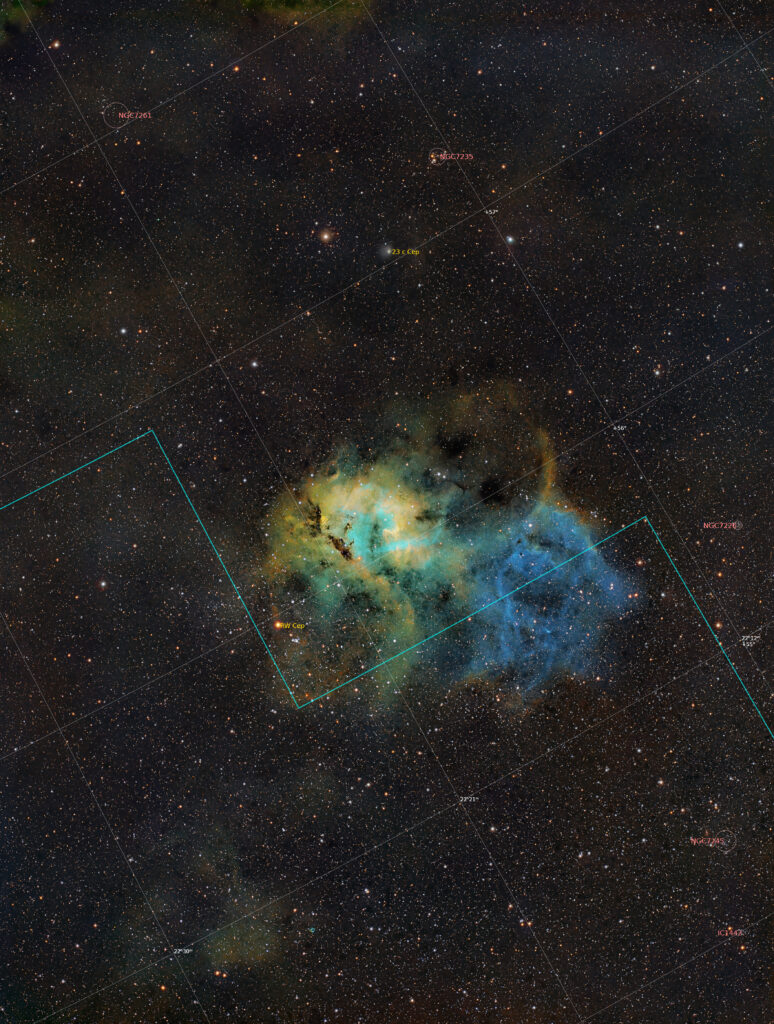
Starless
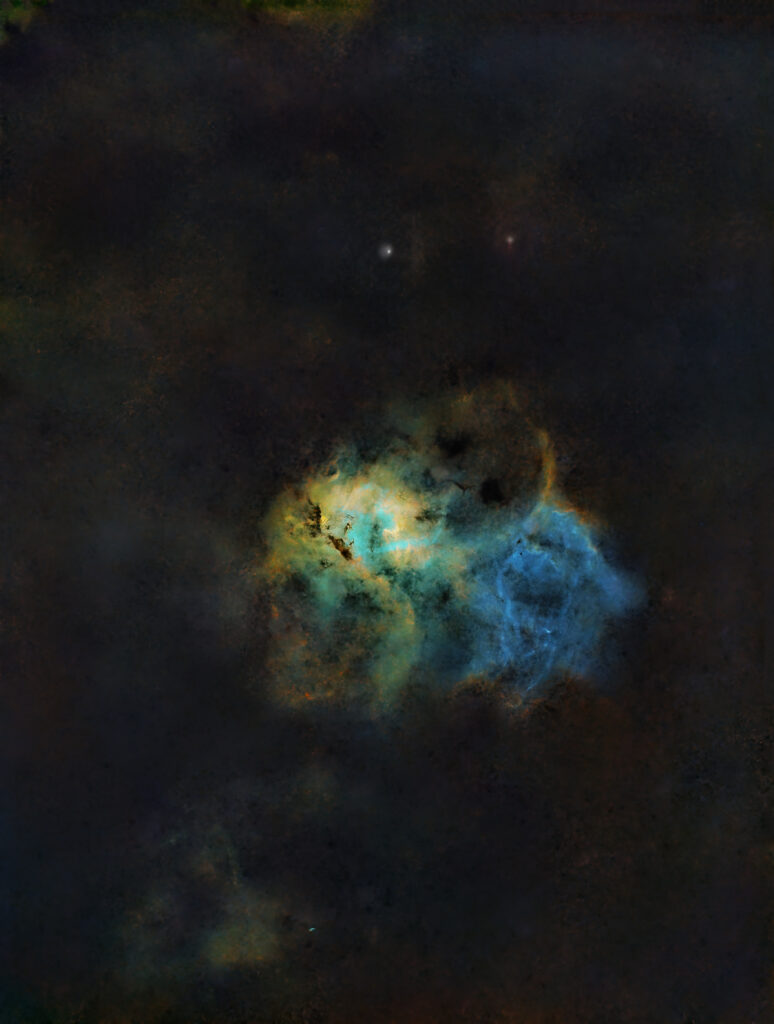
Crop
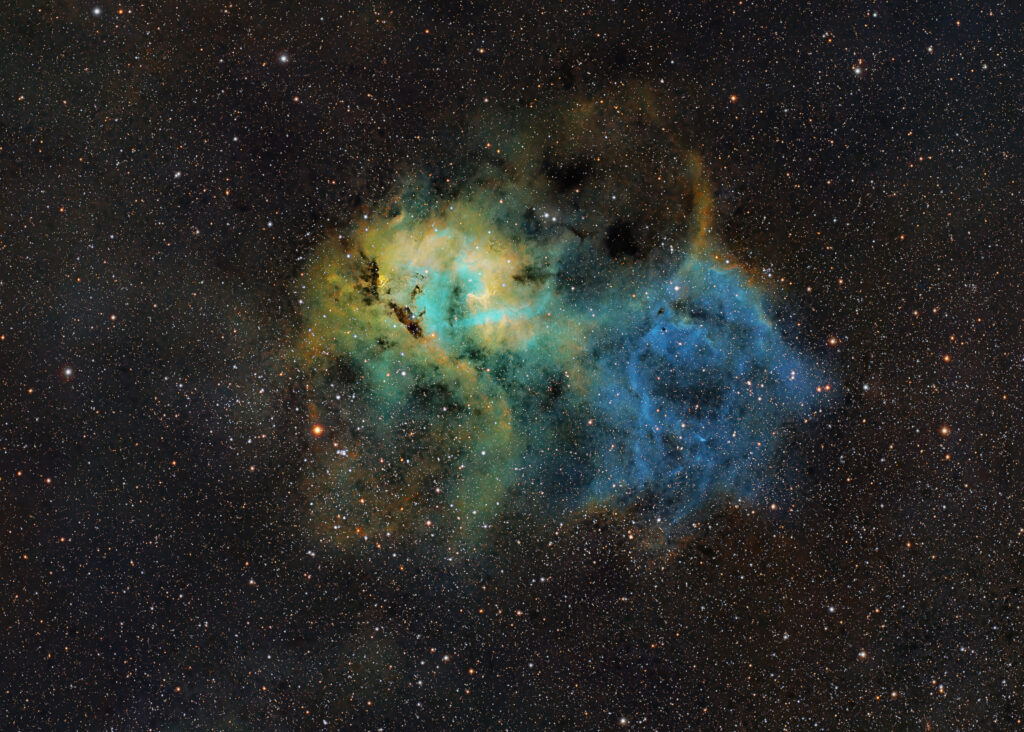
Crop and Starless
